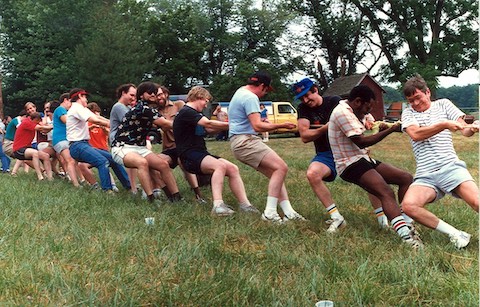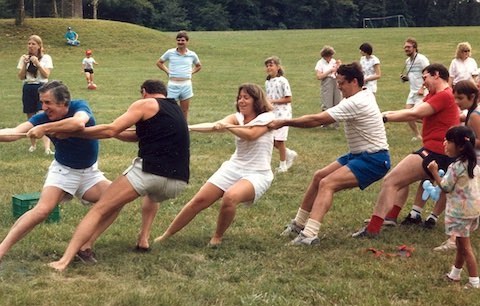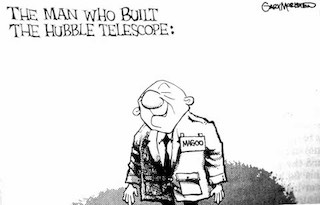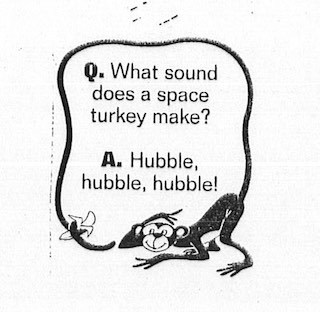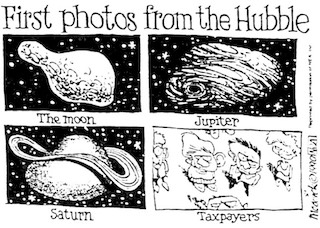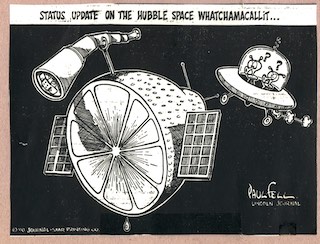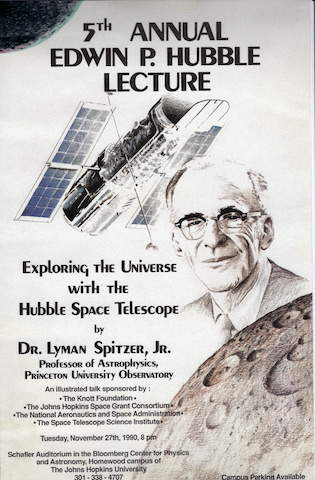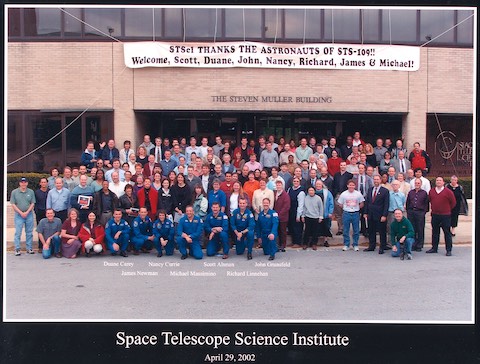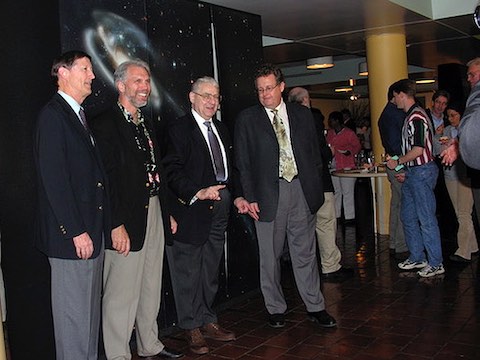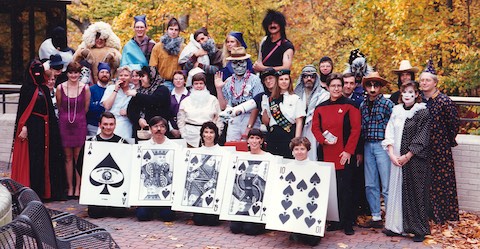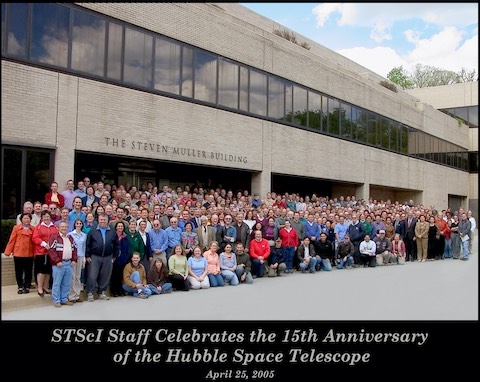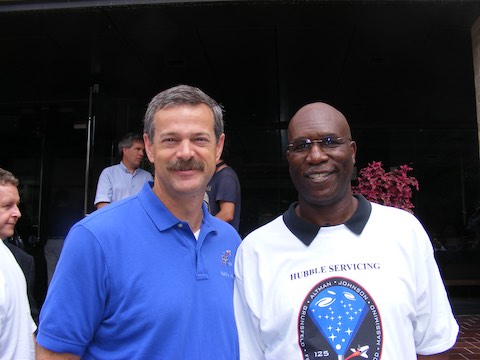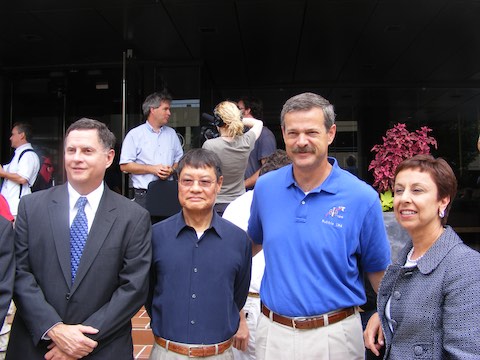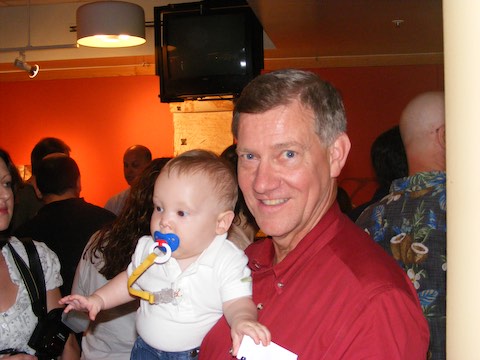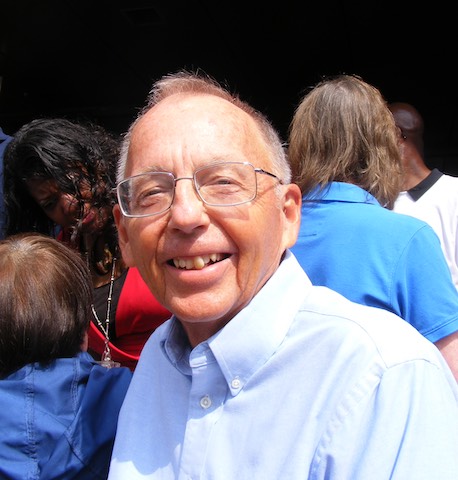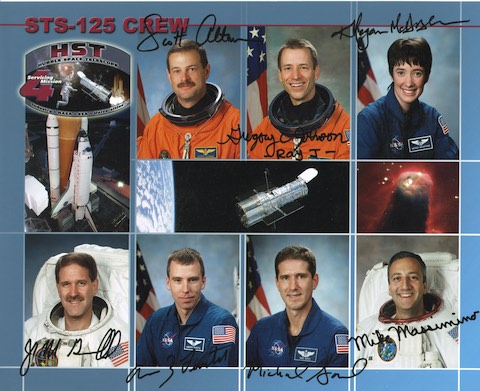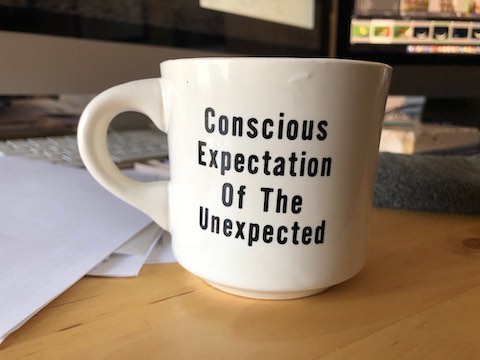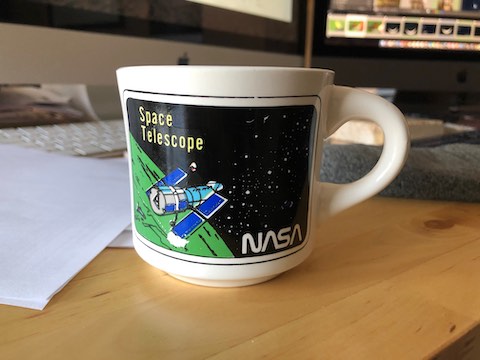Hubble 30th Anniversary
There are four parts to this page:
Picture Gallery
This is a picture gallery of the staff at the STScI,
primarily from its early days, arranged
more or less in chronological order. Some images and documents were shared on the
occasion of the 30th anniversary of Hubble’s launch by
Danny Golombek, Rusty Whitman,
Zolt Levay, Karl Whittenburg, Colin Cox, Bill Hathaway, Forrest Hamilton, and
Vicki Balzano,
and some were images that I had laying around.
The images on this page are all thumbnail reductions of the originals so that the
page will load more quickly. If you click on the image, the full-sized original
will come up. There you can see more detail and download it, if you want. You will have
to use your left arrow to get back to the web page.
Computer Science Corporation staff working at the Space Telescope Science Institute in 1981.
They were in
Rowland Hall before the Muller Building was completed.
Most of these people were reassigned to other projects in December 1981.
Charlie Wu came to the STScI as the CSC manager from the IUE project
in January of 1982. The person standing beside
Dick Williams and behind Kit Harvel is Don Collaizzi.
The image and IDs were provided by Rusty Whitman. Charlie Wu and Barry Turnrose identified
Collaizzi.
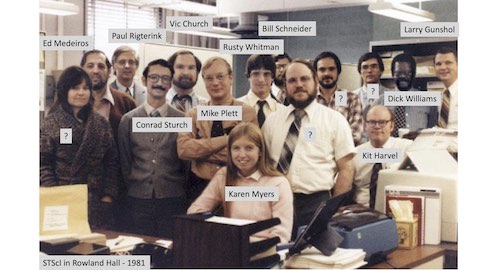
CSC staff outside Latrobe Hall in 1982. Standing: Bill Schneider, Paul Rigterink,
Jim Rose, Charlie Wu, Tony Mallama, Jay Pollack, Karen Myers, and Greg Boeshaar.
Seated: Steve McLaughlin, Conrad Sturch, and Rusty Whitman
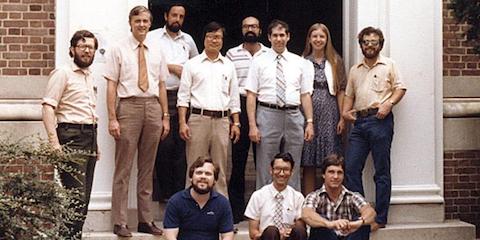
|
Here is a phone list of STScI staff from autumn of 1981. I highlighted it
years later to show the few who remained at the Institute at that time.
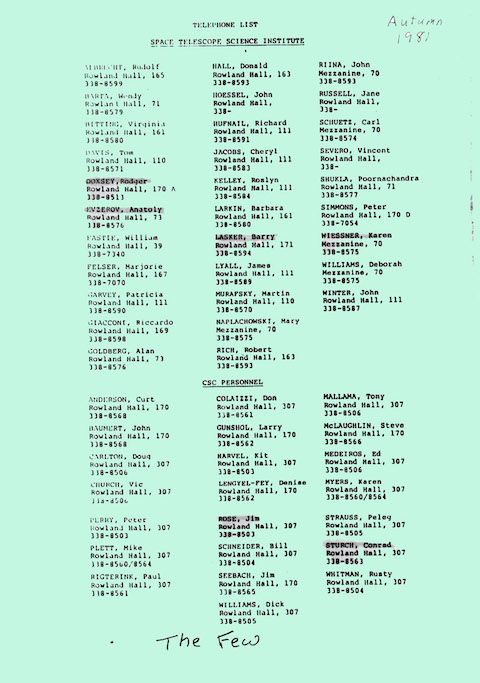
|
The Muller building under construction in April 1982. Image from Zolt Levay.
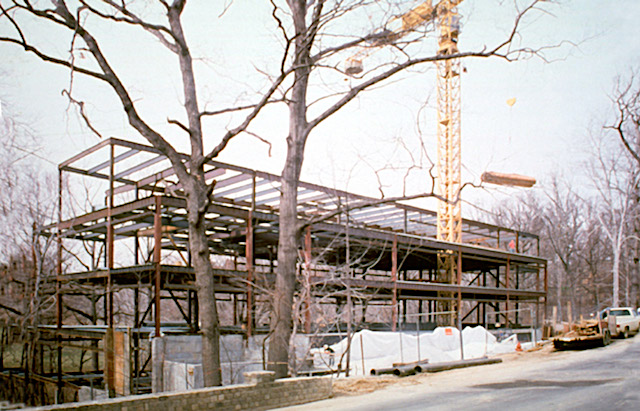
Images during the June 1983 dedication of the Muller Building in which the STScI has been
housed for over 36 years. These images are from Zolt Levay.
|
The completed original STScI building, before the bookends were added
|
Ribbon cutting by Riccardo Giacconi and Steven Muller
|
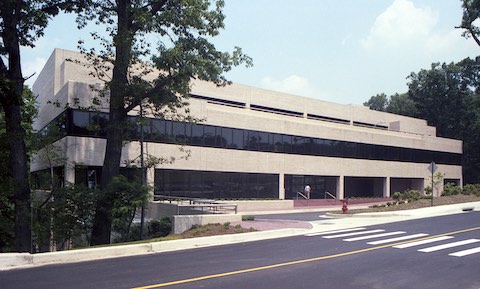
The original building did not last long after the dedication. It was too small for
the organization that the STScI had grown to be. Soon employees were housed in
the lobby and the computer room.
The first step in enlarging it was
to build a parking garage across the street where a flat, L-shaped parking lot had
been originally. The second level of the parking garage was enclosed and software
development teams were housed there. Then “bookends” were added to the north
and south ends of the original building. The software teams moved back in and the
parking garage became fully devoted to parking. But as the staff continued to
grow, groups were housed in rented space in the Bloomberg Building and in the Rotunda.
Click here to see the original staff room assignments.
|
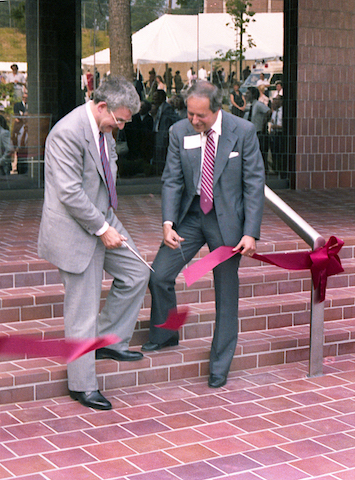
|
SDASers Phil Hodge and Bill Schneider
|
Charlie Wu in room 109, his original office
|
|
Science Data Analysis System
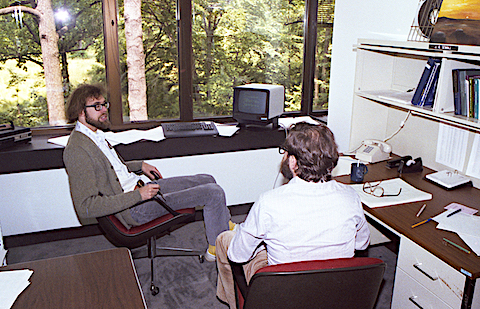
|
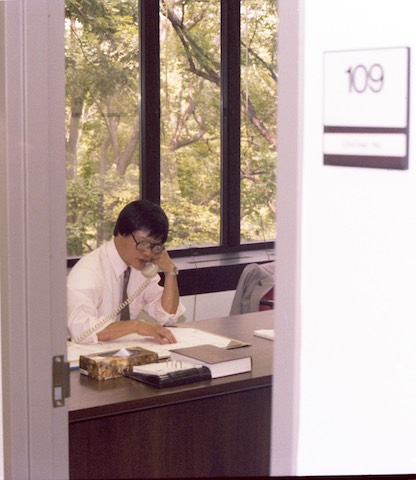
|
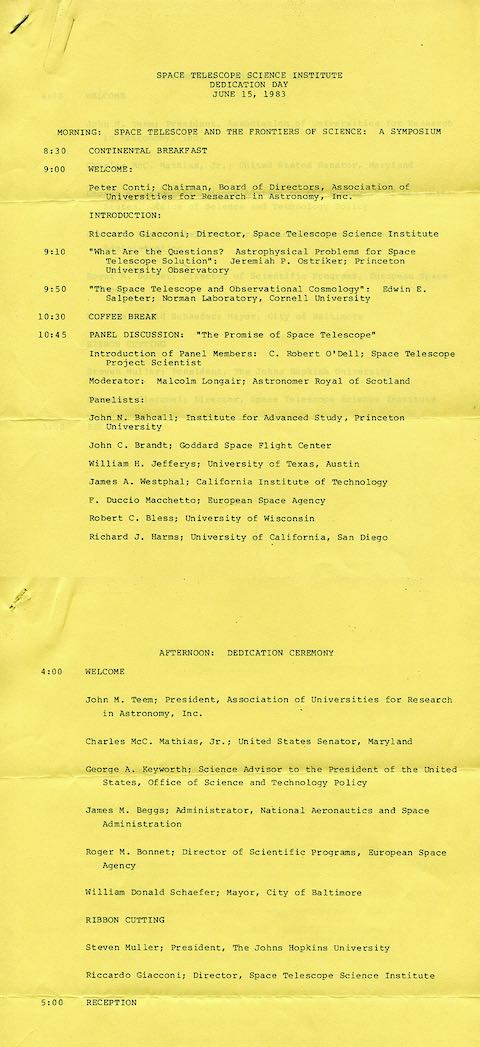
|
 Agenda from the June 15, 1983, dedication of the STScI Agenda from the June 15, 1983, dedication of the STScI
Photo from an April 1984 celebration - Maybe a two-year to launch party?
Includes
Jerry Zavage’s back, Peter Perry, Albert Holm,
Jim Fraher, Eddie Wells, and part of George Sonneborn’s head.
Can you identify the two women?
This photo was provided by Charlie Wu.

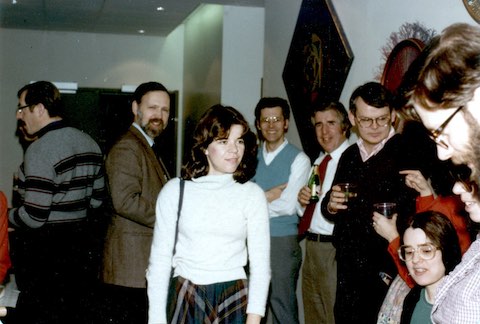
|
The Haw1aiian Pig Roast - STScI’s first Deputy Director, Don Hall, decided
to treat the Institute to a Hawaiian-style pig roast as a team- and morale- building event.
Unfortunately, Baltimore’s soil did not have the same thermal properties as those
in Hawaii.
Images supplied by Danny Golobek
|
Dr. Hall digging the roasting pit
|
About to carve the almost-roasted pig
|
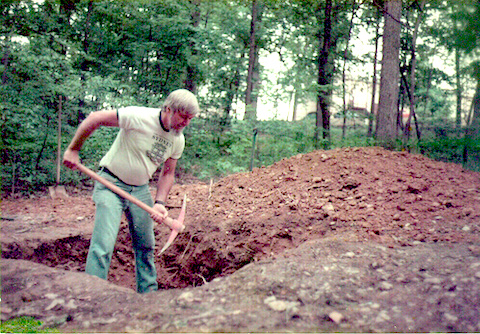
|

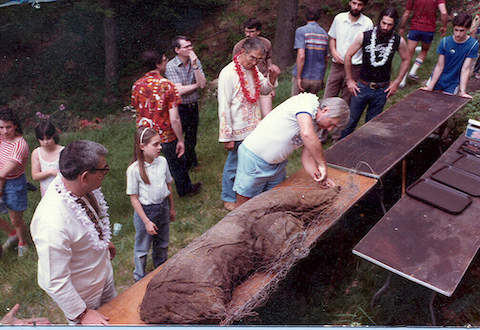
|
All staff photo in 1986
This image was provided by Danny Golombek. Can you find yourself?
Who don’t you see in these all staff photos? John Bedke.
He was always perched on a step ladder at the edge of San Martin Drive,
telling us that if we could not see the camera, the camera could not see us.
Actually, he does appear in one all-staff photo.
See if you can find him farther down this page.
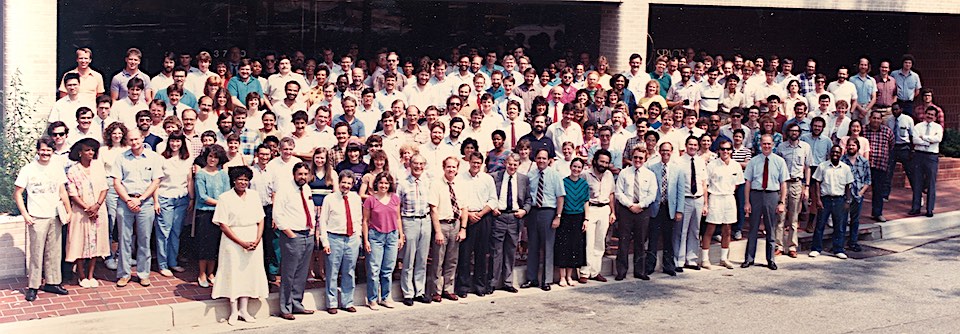
STScI staff directory from 1984 Shared by Danny Golobek
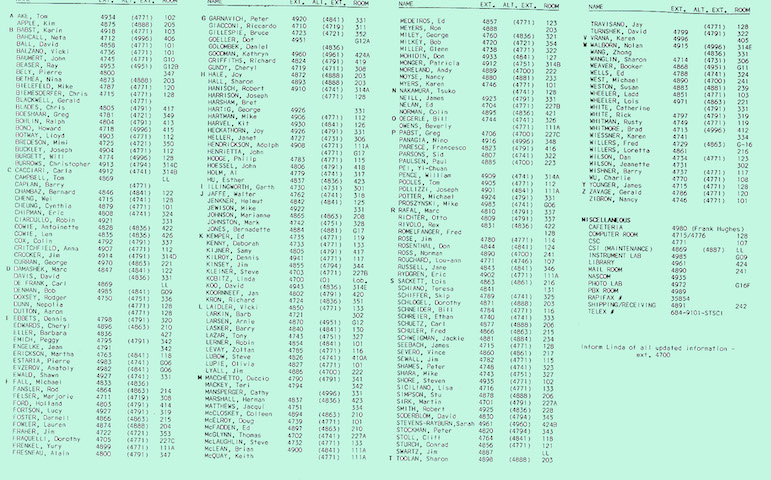
Construction of the East Building/ Parking Garage and parking lot in July 1987. Shared by Zolt Levay
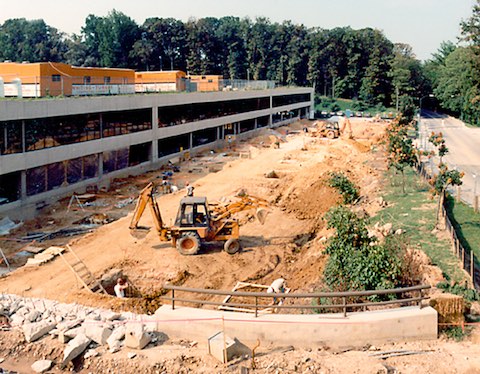
Institute Summer Picnic - During summers, the Institute held an
all-staff picnic. There was food, a pool, and games such as tug-of-war. This
was 1987’s picnic.
Images provided by Danny Golombek.
Preparing for launch
Carrying out tests and simulations, scanning plates for
guide stars, processing telescope use proposals, building trust in one another. In 1985,
TRW delivered the Science Operation Ground System (SOGS), consisting of a
Science Planning and Scheduling System (SPSS), an Observation Support System (OSS),
a Post-Observation Data Processing System (PODPS), and a Support System (SS).
It needed a lot of fixes and improvements to do the job. And it did not have tools
for entering proposals, long-range planning, calibration file development,
creation of a guide star catalog, and providing the observations to the observers.
Those were left up to the user. The STScI responded
with the Proposal Entry Processor (PEP), Spike for long-range planning,
Space Telescope Science Data Analysis System (STSDAS) and Calibration Data Base
System (CDBS) for creating and managing calibration data,
Data Archive and Delivery System (DADS), and the Guide Star Selection
System (GSSS). Informally, Tom Ake and Karl Whittenburg created Scanner to highlight
scheduled real-time events for OSS staff.
|
Dan Rehner working on the Guide Star Catalog
|
Vera Gibbs and Leyla Rutz at the SOGS manager station
after TRW delivered the computers
|
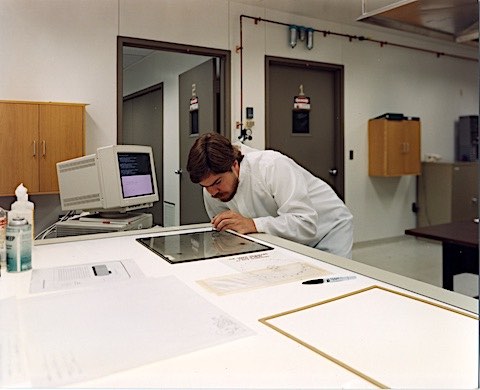
|
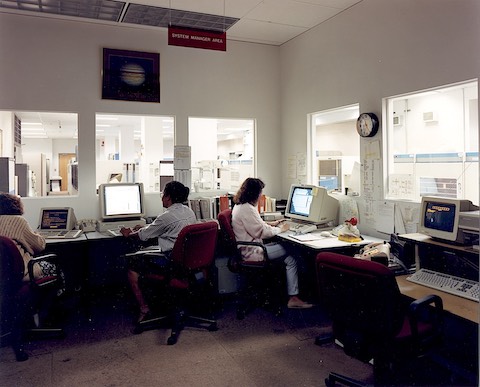
|
Karen Vrana entering the first proposal into the
Proposal Entry Processor (PEP)
Image shared by Danny Golombek
|
Rodger Doxsey, Mark Johnston, Frances Twele, and Bob Jackson
watching PEP milestone
Image shared by Danny Golombek
|
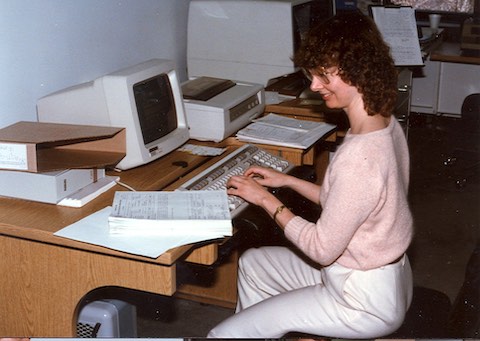
|
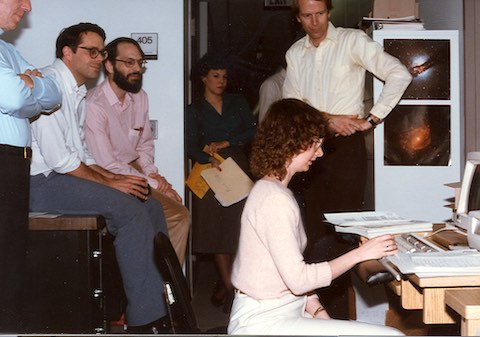
|
Leyla Rutz and Mark Kochte clowning in the OSS operations area
|
The last minutes, Jim Walters and Forrest Hamilton waiting for launch
|
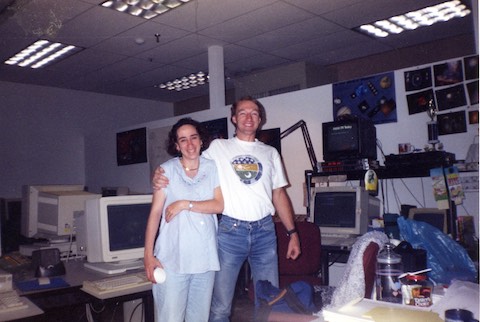
|
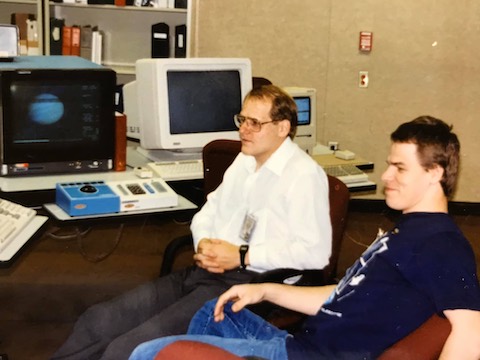
|
|
Anatoly Evzerov in the machine shop. Image shared by Vicki Balzano
|
Anatoly Evzerov at his drafting table. Image shared by Vicki Balzano
|
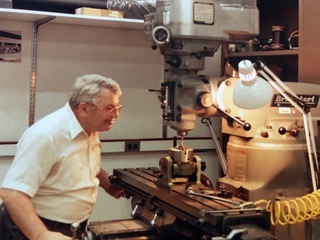
|
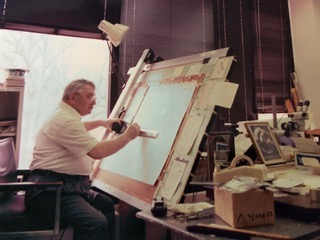
|
All staff photo at the STScI 30 days before the Hubble Space Telescope was due
to be carried into orbit.
Can you find the Director, Riccardo Giacconi, in this photo? Can you find yourself?
Not clear is which launch date is referenced.
There was an attempted launch on April 10 that reached T-4 minutes before
a Auxiliary Power Unit problem caused the launch to be cancelled and rescheduled.
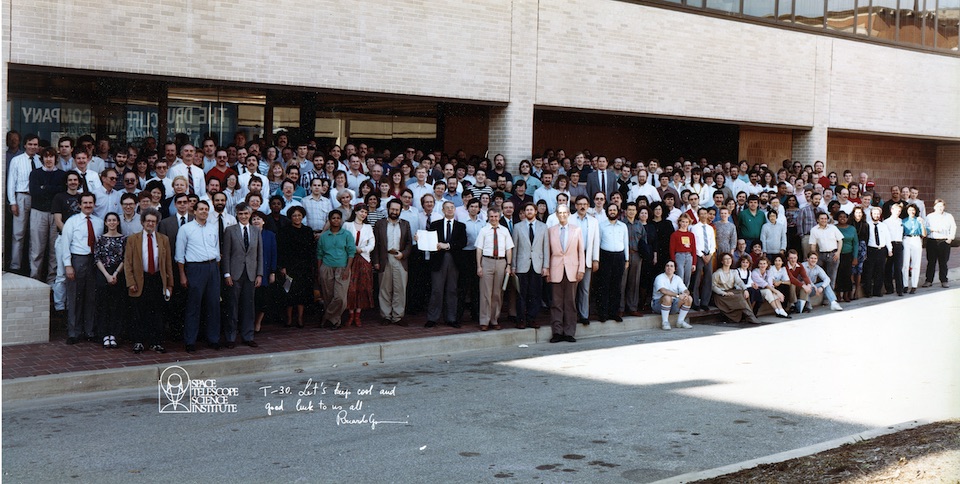
Click here for a version of this all-staff photo with identifications.
Launch!
Hubble was lifted into orbit by Space Shuttle Discovery (STS-31) on 24 April 1990 at 8:33:51 EDT.
The launch was shown in Johns Hopkins University's Shriver Auditorium. Other staff members
watched from the STScI's building.
Discovery's crew was Loren Shriver, Charles Bolden Jr., Bruce McCandless II,
Steven A. Hawley, and Kathryn Sullivan.
This is image 492475main_90pc0610_full-HubbleLanuch from NASA.
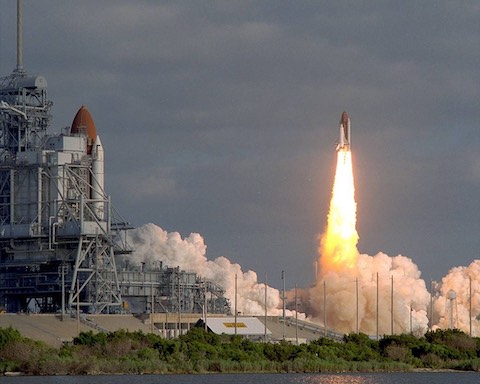
Celebrating the successful launch
|
Dean Zak and Kerry Clark photo from Forrest Hamilton
|
Howard Lanning photo from Forrest Hamilton
|
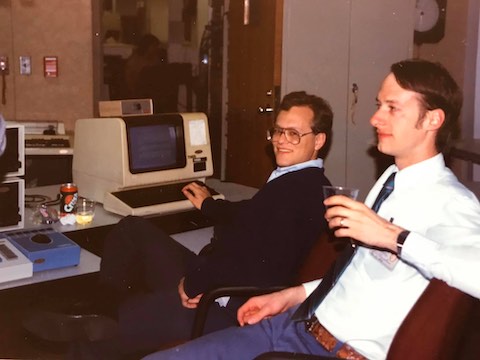
|
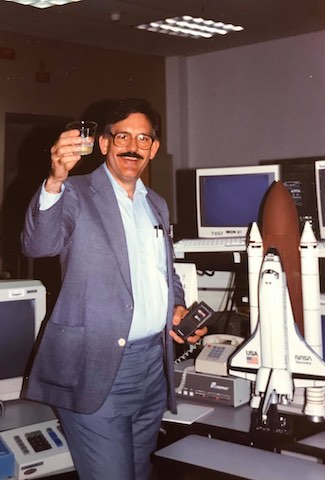
|
Olivia Lupie and Vicki Balzano
photo from Danny Golombek
|
Scott Binegar, Al Holm, Kent Reinhard, Dorothy Fraquelli,
and Olivia Lupie
|
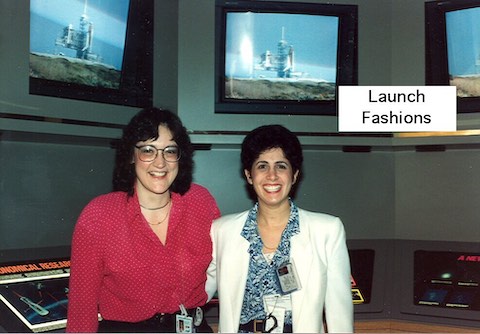
|
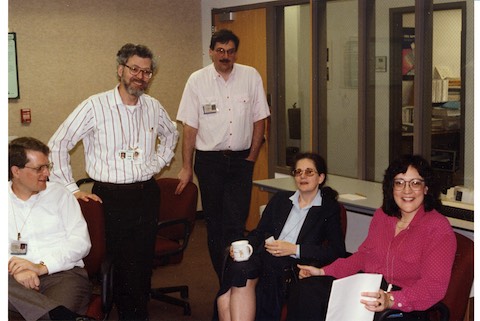
|
To Work!
STScI’s Orbital Verification Team - Among others, here are
Merle Reinhart, Dean Zak, Ed Bell, Kent Reinhard, John Hershey,
Mimi Bredeson,
Jim Younger, Jim Fraher, Mike McCollough,
Lauretta Nagel, Wayne Baggett, Don Chance, Doug McElroy,
Steve Kraemer,
Wayne Kinzel,
Bill Hathaway, Glenn Schneider,
Eric Chipman, Vicki Balzano,
Pat Parker, Olivia Lupie, Charlie Kowal,
Skip Schiffer, Rodger Doxsey, and Mike Perkins.
Image shared by Danny Golombek.
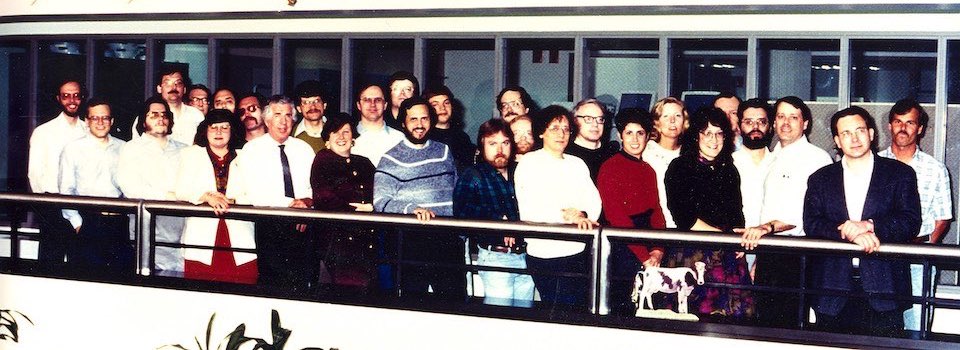
|
Jim Roberts at SPSS operations
|
Observing the first stored command sent to the NSSCI, a NOOP
Standing: Riccardo Giacconi, Ethan Schreier, and Roger Doxsey, and
Seated: Glenn Schneider. Photo shared by Glenn Schneider
|
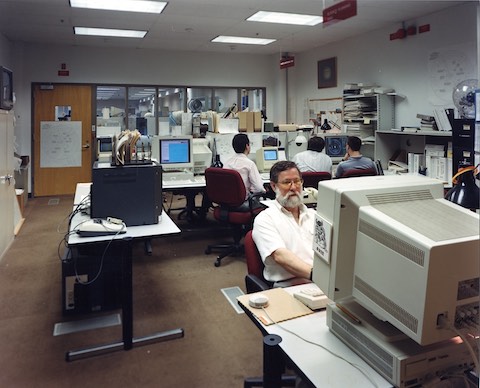
|
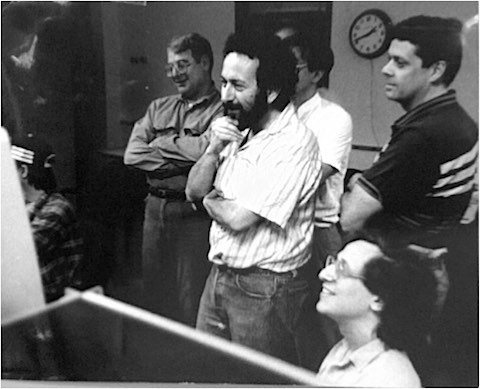
|
|
During the initial months after launch,
Science Institute staff operating the
Observation Support System were
required to work at Goddard.
This helped coordination between the STScI staff and Lockheed Martin's flight operation team
and it had the benefit of giving
the flight operations staff a chance to see the raw data resulting from their work.
However, because members of the OSS team lived in Baltimore, their commute was wearisome.
Shortly before Thanksgiving in 1990 and nearly seven months after launch,
the Hubble Project allowed the OSS staff
to return to their home base in Baltimore.
Of course, they still had to continue operations through the holiday as did the operations staff
for SPSS and PODPS,
the Computer Systems managers, and the Science Mission Managers.
Most team members were single and did not have family in the area.
To make holiday work more tolerable and to celebrate the return from Goddard,
Helen Hart and Dorothy Fraquelli decided to hold a
Thanksgiving potluck for the staff in the operations area.
The accompanying photos are from that November 1990 feast.
We continued to have Thanksgiving at the 'Tute for a number of years afterwards,
even after the software and the Project's confidence had improved enough that we could allow
the systems to go for a day without staffing.
Eventually management caught on to what we were up to and decided that,
since we did not have to be at work, we should not be at work.
We had had good times while it lasted.
|
Gary Anderson, Helen Hart,
and Ian Wilson’s back
|
Steve Kleiner, Unknown back,
Clark Merrill, and Douglas Holm
|
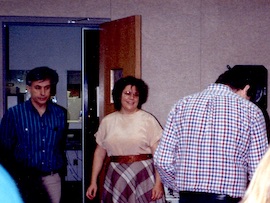
|
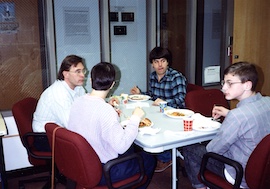
|
Maybe Karl Whittenburg’s back, Terri
Gipson, Ian Wilson, Al Holm,
and Phil Van West
|
Rick Wasatonic at his post
|
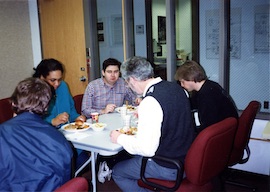
|
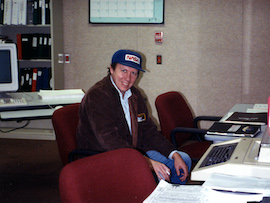
|
|
Operations Division staff in 1990 Image contributed by Karl Whittenburg
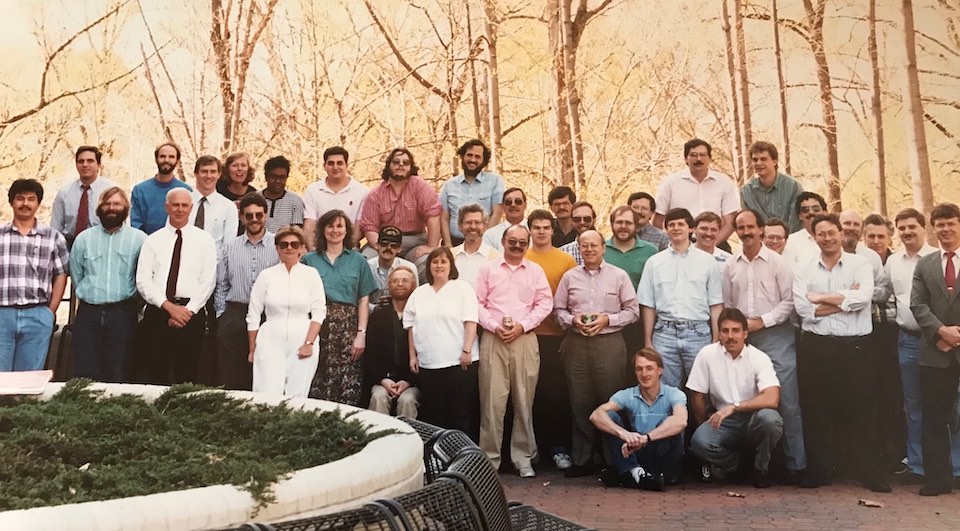
Science Computing and Research Support (SCARS) Division in 1990.
Note that John Bedke is in this one, at left. Image contributed by Zolt Levay
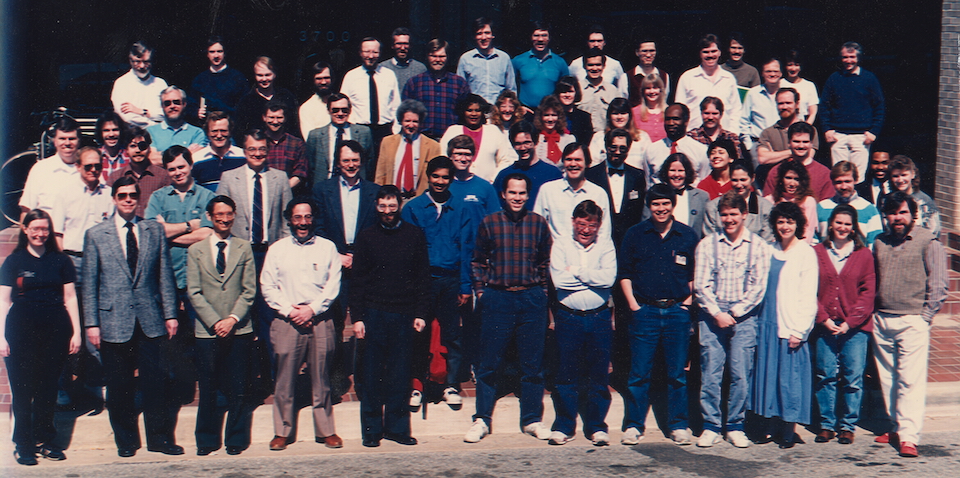
Science Programs Division (SPD) in 1990. Image contributed by Danny Golombek.
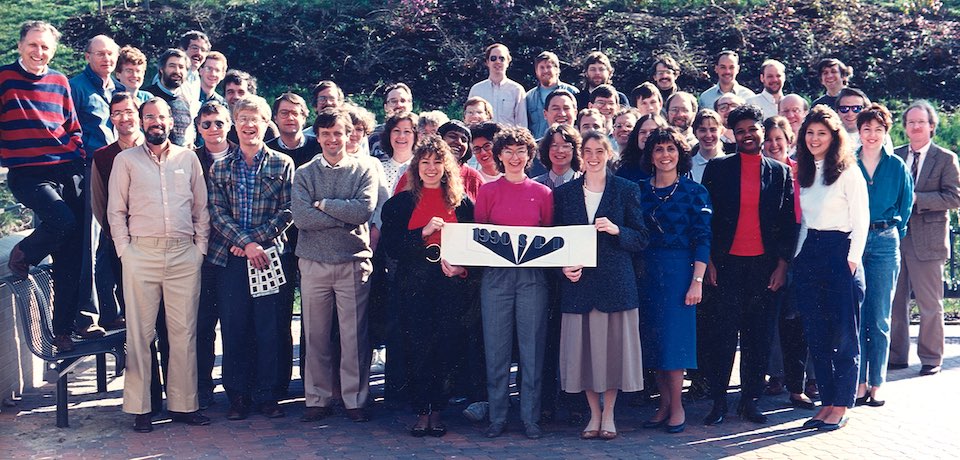
Eddie Wells, Karl Whittenburg, and John Scott in OSS.
Image shared by Karl Whittenburg
|
Mark Kochte, Helen Hart, and Lloyd Rawley preparing to adjust
the telescope pointing
via a SOGS Invokable Procedure (SIP).
Image shared by Danny Golobek.
|
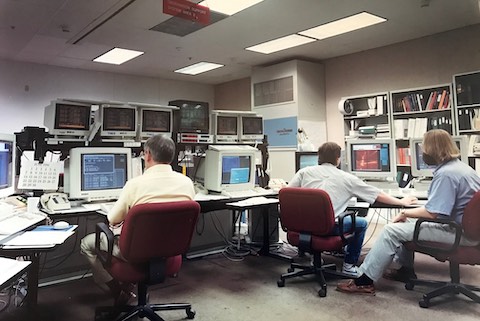
|
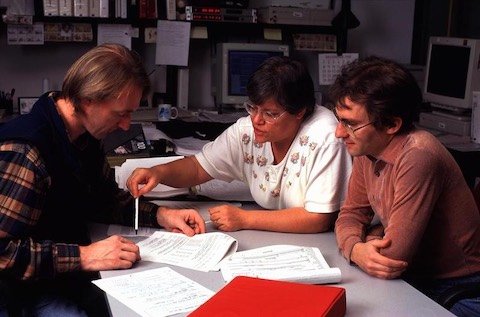
|
Embarrassment and Disgrace
The mirror was flawed, but good science was still
possible. The Spitzer lecture poster and two of the cartoons were contributed by Bill Hathaway.
|
Story from Eliot Malumuth
Tom Ake and probably Glen Wahlgren will remember this. I call it “the image that
saved Hubble”. I don’t know if anyone else does.
It was the main contributor to the press release of August 13, 1990.
The image was a WF/PC image taken by the GHRS team (as explained below)
on August 3, 1990. A simple search reminded me that the news conference
announcing the Spherical aberration was June 27, 1990.
I was selected to join the CSC science support team for the GHRS as the Imaging
“expert”.
Despite the trouble with the aberration, the commissioning tests were proceeding.
Dennis Ebbets the GHRS person at Ball Aerospace had made a test to make sure that
the GHRS 5x5 target acquisition mosaic was being put together correctly into an image.
He chose as the “truth” image a WF/PC image of R136 inside 30 Doradus. It was supposed
to give enough of a unique looking field to know if the mosaic squares with
aligned correctly.
There was a time R136 was thought to maybe be a single supermassive star.
Speckle interferometry by Weigelt and Baier resolved this into a handful of stars.
When we got the “truth” image for this test I was given the images
and asked to see what I could make of it. I counted about 50 separate stars
(the cores were still sharp) on top of a very diffuse
“background” made up of the wings of the aberrated PSF
(the top right panel in the press release). A nice science result
right out of the box. We realized that this was good news at a time that HST needed some.
Don Lindler did a deconvolution of the image (lower right).
I remember going to the institute with a draft of final press release image (The actual
press release was put together by the institute).
I went up to the STScI with Sally Heap, and maybe Tom Ake and talked
to someone (Barry Lasker? - I don’t actually remember who it was we talked to)
to show what we had found. But it was seen that this would be a good news press release.
And so it was. And helped spark the deconvolution cottage industry.
|
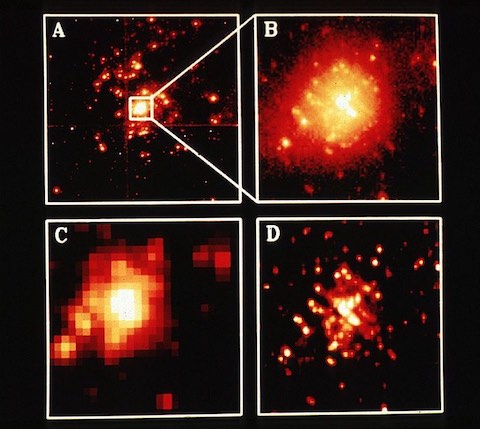
Panel A is a portion of a image made with the Wide Field/Planetary Camera
on August 3, 1990, showing the compact star cluster R136.
Panel B is the central portion of the HST image.
The star images have bright cores that are only 0.1 arcseconds wide,
allowing many more stars to be distinguished than in previous ground-based telescopic photos.
Panel C is a photograph of the same region as Panel B,
obtained with the Max Planck 2.2-meter telescope at the
European Southern Observatory by Dr. Georges Meylan.
The star images are 0.6 arcseconds wide.
Panel D shows how computer processing of the HST image in Panel B has sharpened its appearance.
The undesirable fuzzy halos around the stars as seen in Panel B are substantially reduced.
|
The Faint Object Camera team in 1992 Among others are Christ Blades,
Rudi Albrecht, Bill Sparks, Duccio Machetto, Robert Jedrzejewski, Ivan King,
Perry Greenfield, Antonella Nota, and Francesco Paresce.
Image shared by Danny Golombek.
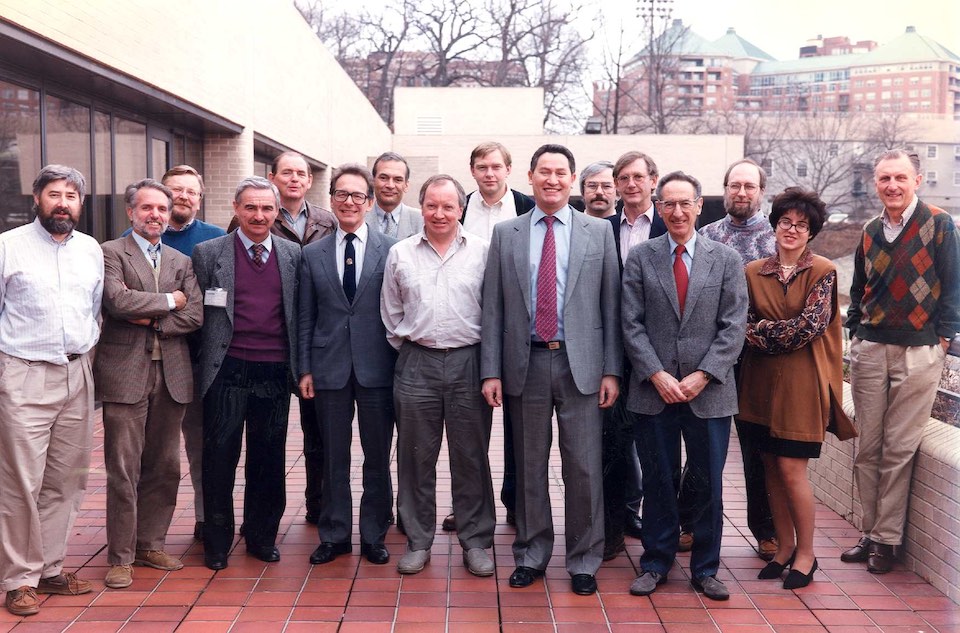
SCARS in 1992 Team members, not in order and not all present, are
Don Stevens-Rayburn, Skip Westphal, John Godfrey, Al Havrilla, Bob Hanisch,
Dave Paradise, Conrad Sturch, Harry Payne, JC Hsu, Ron Allen, Helmut Jenkner,
Steve Hulbert, Dave Soderblom, Herb Kennedy, Betty Stobie, Bernie Simon,
Nelson Zarate, Dick Shaw, Ray Williamson, Phil Hodge, Zolt Levay, Ed Smith,
Jon Eisenhamer, Phil Grant, Barry Lasker, Brian McLean, Dave Bazell,
Roz Baxter, Jeff Hayes, Marc Postman, Anatoly Evzerov, Mark Stevens,
Blaise Canzian, Kip Kuntz, Diane (Gilmore) Karakla, Greg McLeskey, Allen Farris,
Jim Scott, Matt McMaster, Fabienne van de Rydt, Sharon Collins Barkhouser,
and Patty Reeves.
Image contributed by Zolt Levay
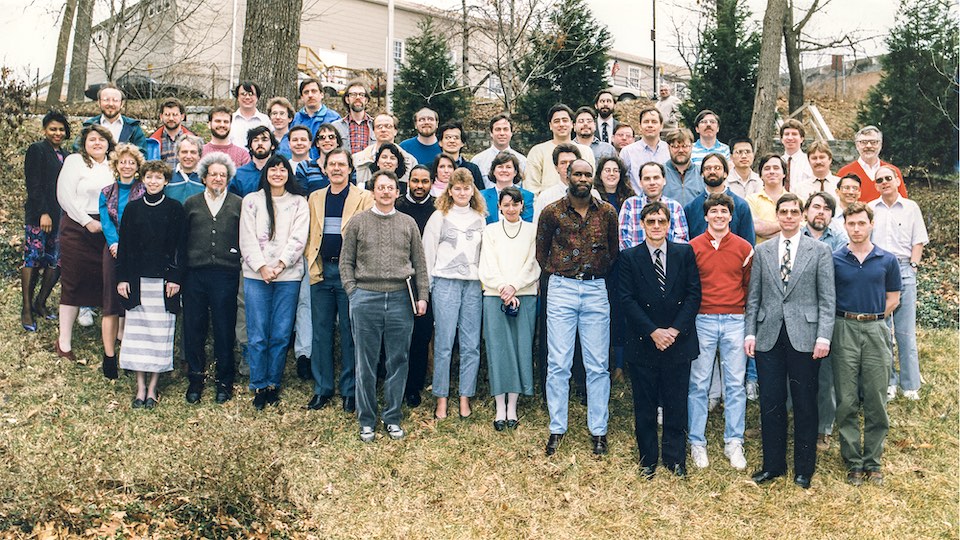
Servicing Mission 1 - Hubble Is Rescued
Servicing Mission 1 was carried out by astronauts Richard Covey, Kenneth Bowersox,
Story Musgrave, Kathryn Thornton, Claude Nicollier, Jeffrey Hoffman and Tom Akers
flying in the Shuttle Endeavor. The STS 61 mission launched on December 2, 1993,
at 4:27 AM EST.
Before it was over, they replaced WFPC with WFPC-2, and substituted the
Corrective Optics Space Telescope Axial Replacement (COSTAR) for the
High-Speed Photometer, giving all the instruments, except the HSP of course,
the view of the universe that they were intended to have.
The astronauts also installed
two Rate Sensing Units (RSUs) - each housing pair of gyroscopes,
two Electronic Control Units which direct the RSUs, eight electrical fuse plugs.
new solar arrays that eliminated the jiggle caused when crossing between night and day,
two new magnetometers, and co-processor to enhance memory and speed of Hubble’s computer.
STScI staff wishing the SM1 astronauts good luck Image shared by Danny Golombek.
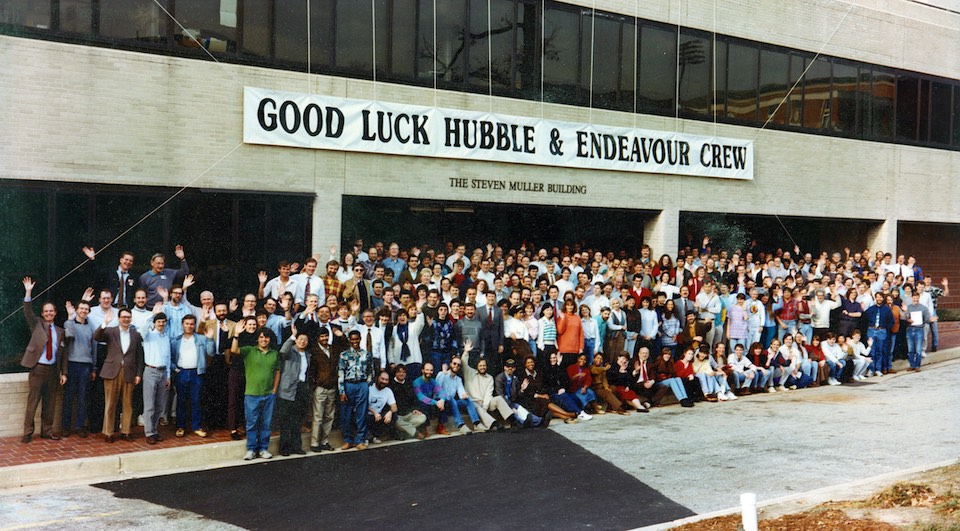
Staff of the Operations Software Branch Image shared by Danny Golombek.
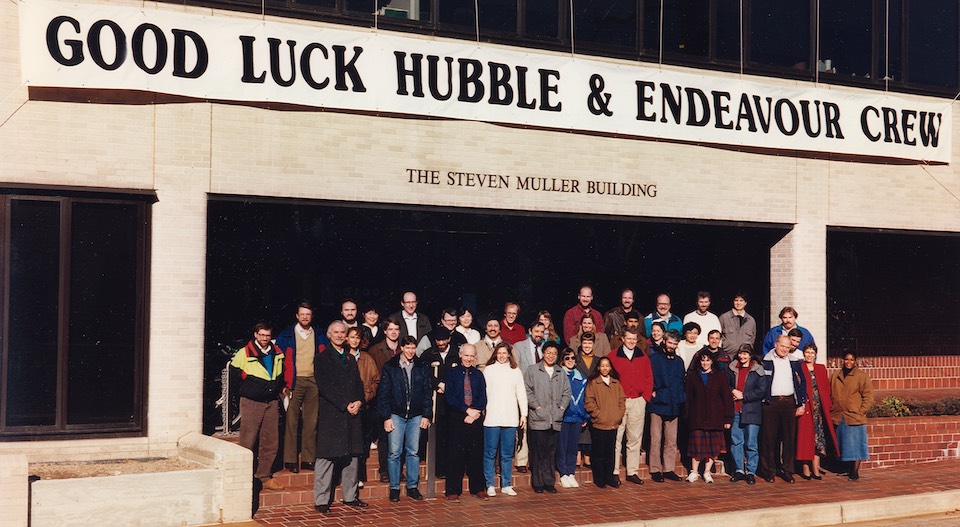
NASA image PAO/STS61/10093023
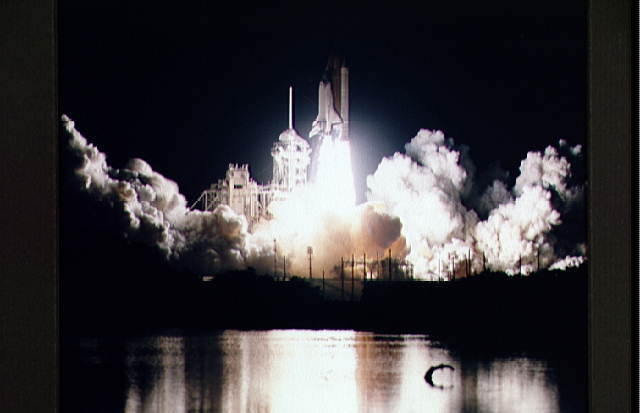
Celebrating the success of SM1
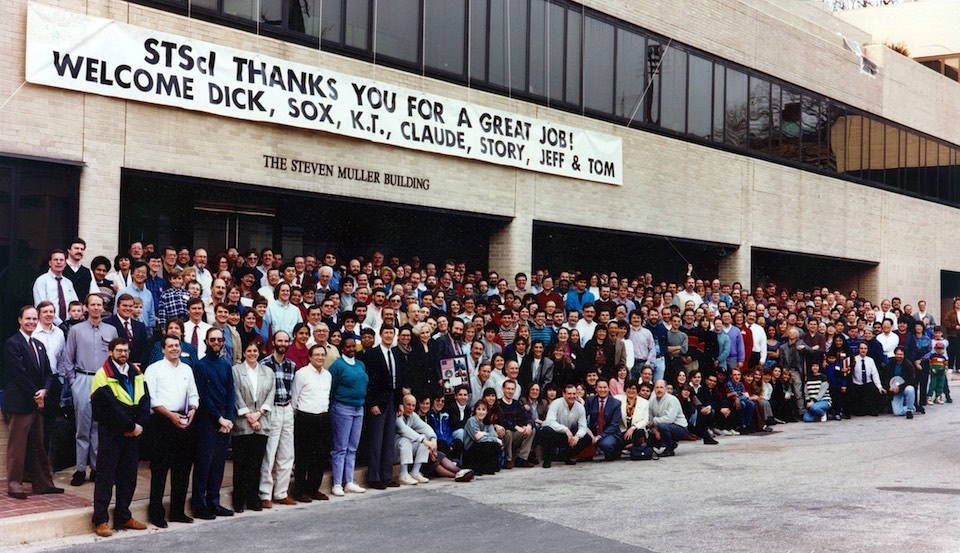
Before left: M101 with WFPC on November 27, 1993
After right: M101 with WFPC-2 on December 31, 1993
|
Viewing the impact of Comet Shoemaker-Levy 9
on Jupiter July 16, 1994
Image shared by Karl Whittenburg.
|
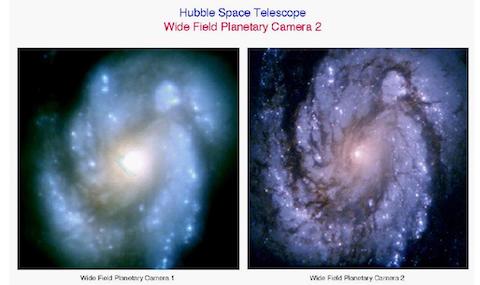
Standing by bookshelves: Dave Taylor and Mario Livio.

Standing: Keith Noll,
Hal Weaver, Melissa McGrath, John Clarke, 3 whose names I don’t know,
and Bob Williams.
Seated: Karl Whittenburg, Heidi Hammel, Reta Beebe in the yellow shirt, one whose name I don’t know, and Dorothy Fraquelli.
|
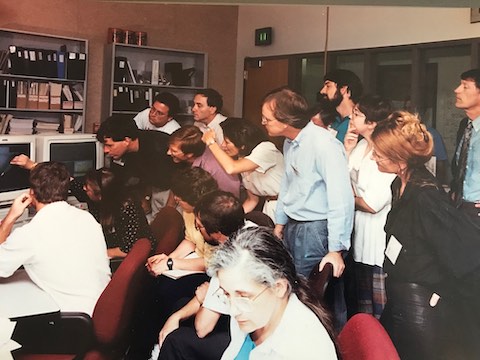
|
Celebrating the processing of 100,000 observations (and the scheduling of at least that many)
Image shared by Danny Golombek.
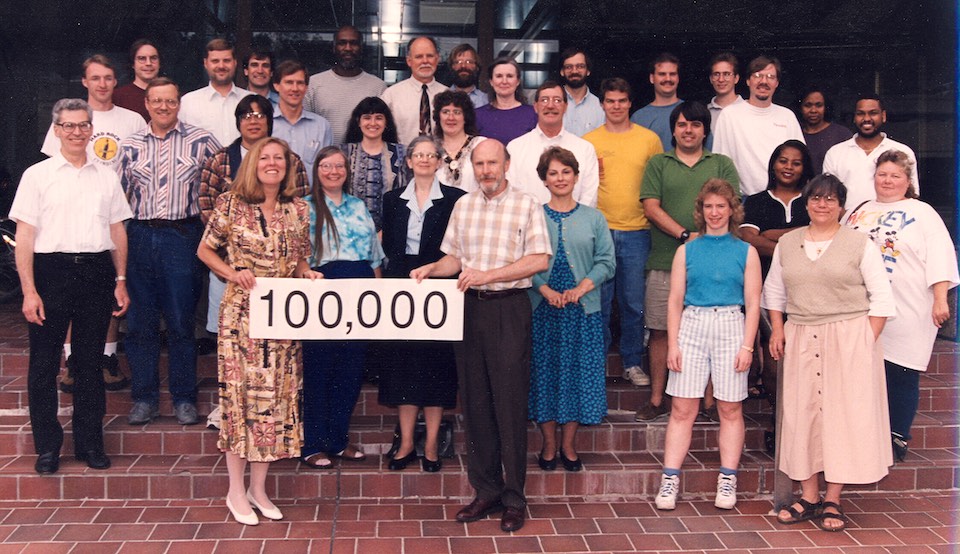
Staff contributing to the development of the OPUS system
OPUS combined and improved on the TRW systems, PODPS and OSS.
OPUS continued to be used at the STScI until April 2020.
OPUS
was also used by Celera Genomics in its effort to
decode the human genome.
From left to right are Phil Goldstein, Christine Heller,
Ken Steuerman, Forrest Hamilton, Al Holm, James Cunningham, Teck Hock Choo, Pete Hyde,
Rick Perrine, Bob Dempsey, John Scott, Jim Rose, Mary Alice Rose, Sid Parsons,
Steve Slowinski, Dorothy Fraquelli, and John Ayscue.
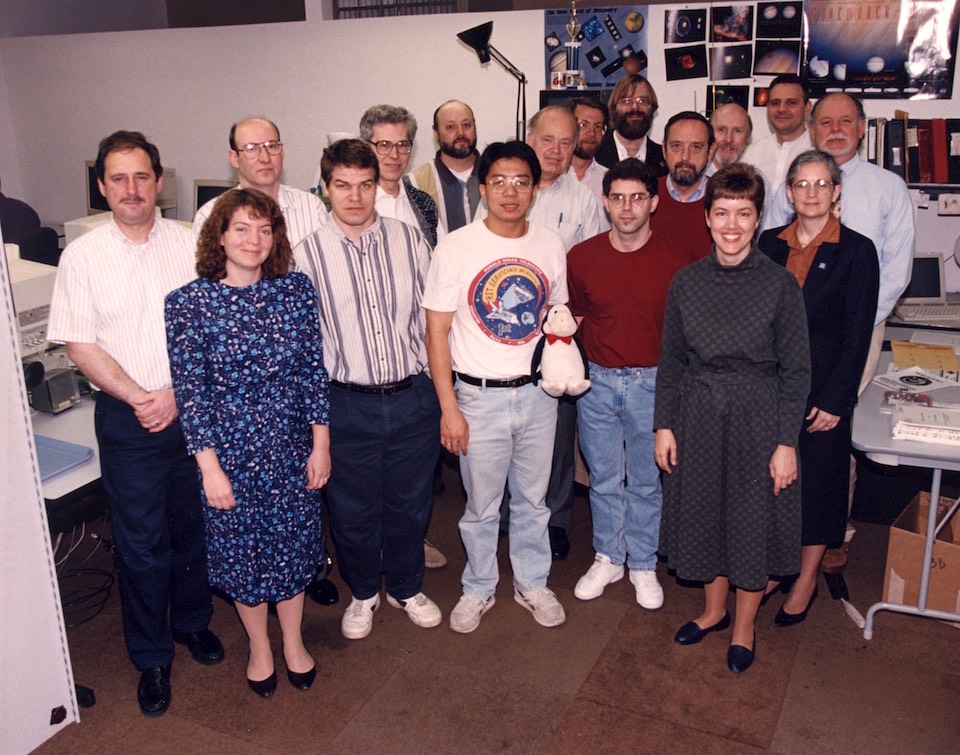
|
Forrest Hamilton and Mark Kochte in OPUS. Image shared by Danny Golombek.
|
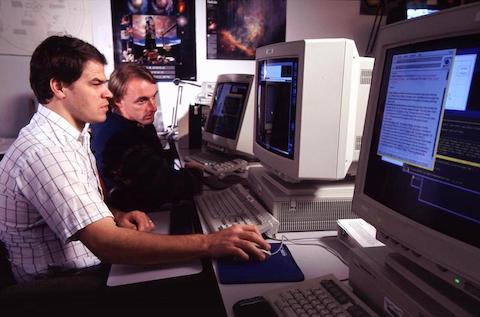
|
Goddard High Resolution Spectrograph (GHRS) Science Conference
The conference on The Scientific Impact of the Goddard High Resolution Spectrograph
took place at GSFC on September 11-12, 1996. Audience members include
Nancy Grace Roman and Lyman Spitzer, Jr., and many other senior astronomers and
members of the STScI. Click on the image to see a version with
a list of the names of the audience members.
Image contributed by Glenn Wahlgren.
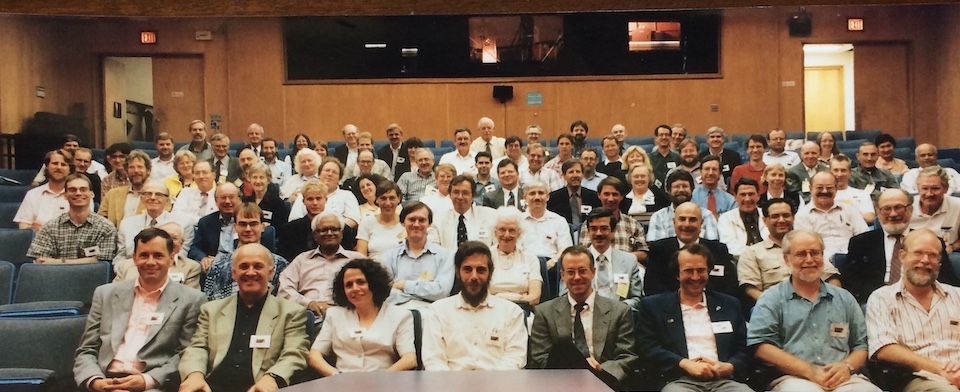
Servicing Mission 2 - New Instruments, New Capabilities
Servicing Mission 2 (STS 82) was carried out by astronauts Kenneth Bowersox, Scott Horowitz,
Mark Lee, Steven Hawley, Gregory Harbaugh, Steven Smith and Joseph Tanner.
Shuttle Discovery lifted off from its pad on February 11, 1997, at 3:55 AM EST,
another night launch.
The Goddard High Resolution Spectrograph (GHRS) was replaced by
the Space Telescope Imaging Spectrograph (STIS) and the
Faint Object Spectrograph (FOS) was replaced by the
Near Infrared Camera and Multi-Object Spectrometer (NICMOS).
Enhancements were made by
installing a new unit called the Optical Control Electronics Enhancement Kit
and by replacing a
reel-to-reel-style Engineering and Science Tape Recorder with a new digital Solid State Recorder (SSR).
The mission also replaced a Fine Guidance Sensor, a Reaction Wheel Assembly, a
Data Interface Unit, and the Solar Array Drive Electronics package, and
installed more thermal insulation blankets.
The telescope’s orbit was boosted by eight nautical miles.
Wishing the STS-82 astronauts a successful mission Image shared by Danny Golombek.
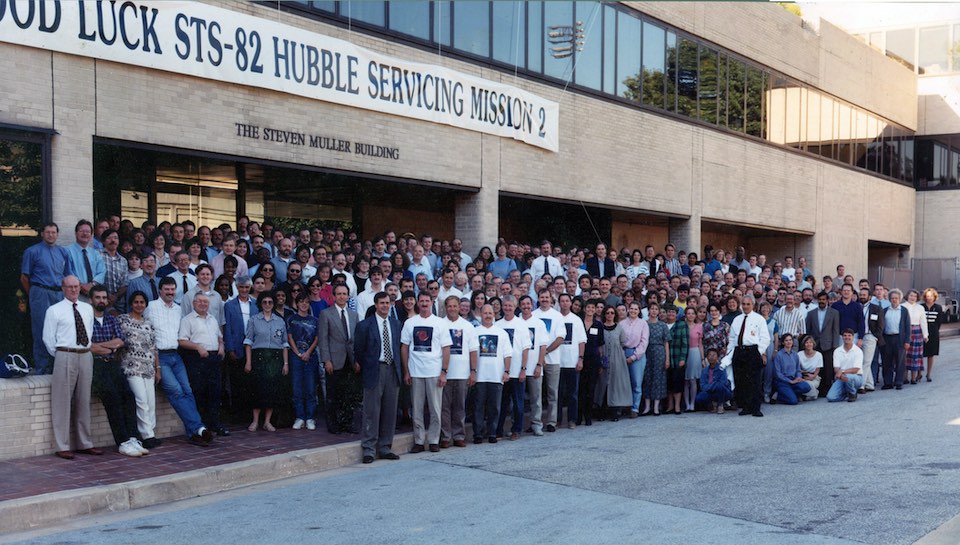
nssdc.gsfc.nasa.gov/image/spacecraft/sts-82.jpg
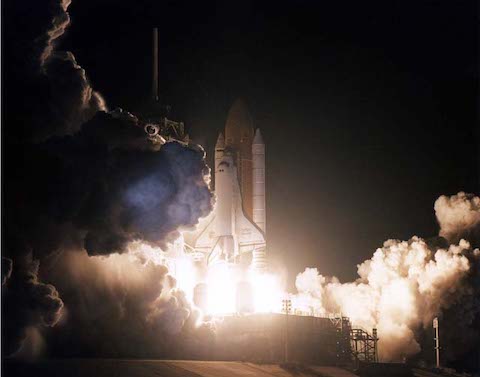
On Oct 22, 1998, the Operations Division celebrated processing
HST’s 250,000 observation. Image shared by Danny Golombek.
|
Hubble Flight Operations at the STScI from 1999 until 2006
|
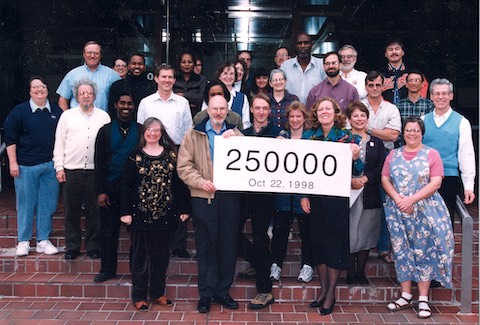
|
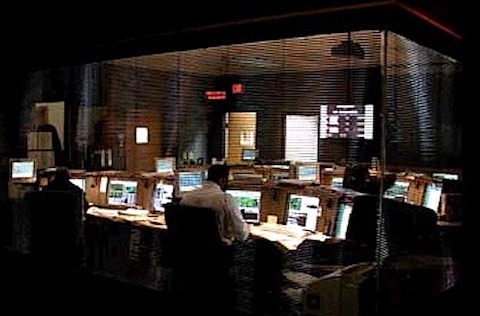
|
Servicing Mission 3a - Emergency Repairs
A third servicing mission was originally scheduled for June 2000.
When the third of Hubble’s six gyroscopes failed,
it was split into two separate missions, the first
primarily for hardware repairs and the second primarily for science enhancements.
The first mission, STS-103, launched on December 19, 1999, 7:50 PM EST
with astronauts
Curtis Brown, Scott Kelly, Steven Smith, Michael Foale, John Grunsfield,
Claude Nicollier and Jean-Francois Clervoy.
During this mission, the astronauts
replaced all three Rate Sensor Units containing two gyroscopes each,
and installed six Voltage/Temperature Improvement Kits
between Hubble's solar panels and its six 10-year-old batteries,
a new advanced computer,
a new Fine Guidance Sensor,
a Transmitter replacing one that failed in 1998,
and another solid state digital recorder, replacing an older mechanical reel-to-reel recorder.
STScI staff with the SM3a astronauts Image shared by Danny Golombek.
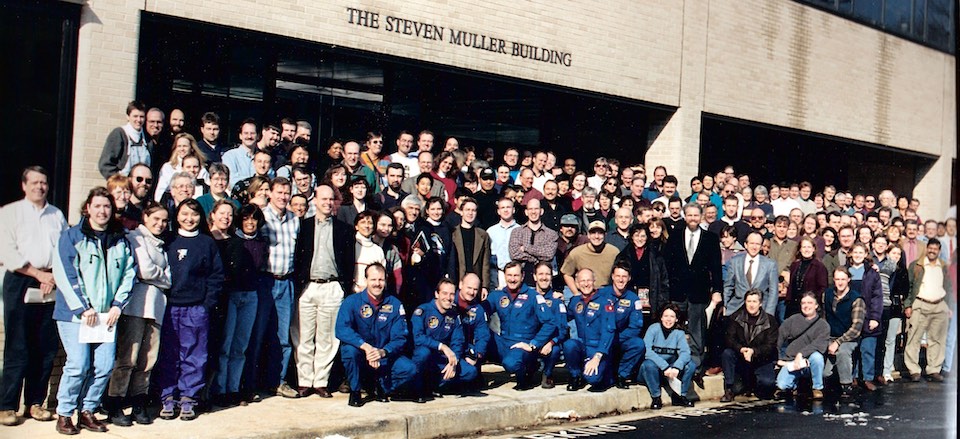
NASA sts103-501-026orig.jpg
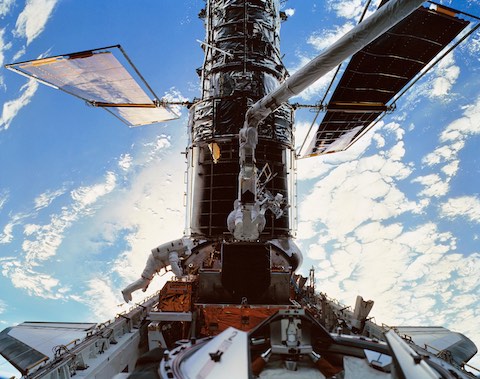
10th Anniversary of Hubble Image shared by Danny Golombek.
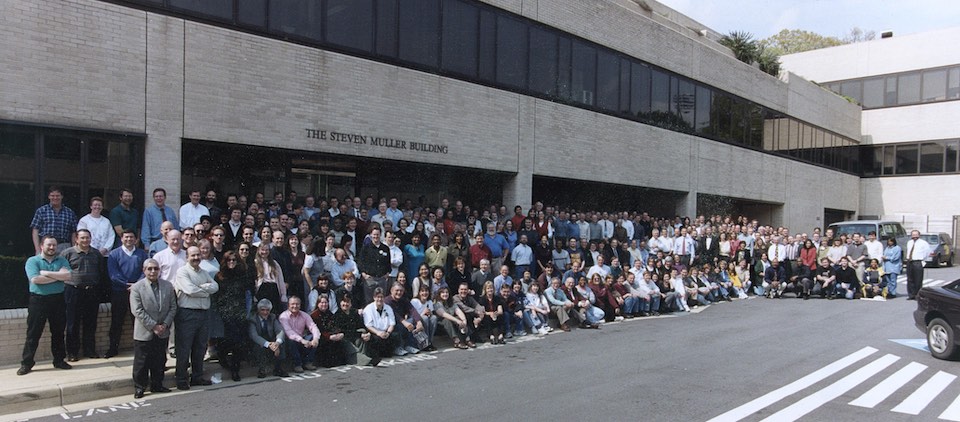
Servicing Mission 3b - Another New Instrument
The second part of the third servicing mission
was crewed by astronauts Scott Altman, Duane Carey, John Grunsfeld, Nancy Currie, James Newman, Richard Linnehan and Michael Massimino
The Shuttle Columbia (STS 109) lifted off from the Kennedy Space Center
at 6:22 AM EST on March 1, 2002.
They replaced the Faint Object Camera with the Advanced Camera for Surveys (ACS)
and gave the NICMOS new life by adding a cryocooler.
They also installed new solar arrays, and replaced a Reaction Wheel Assembly and
a Power Control Unit.
STScI staff with the SM3b astronauts before the flight Image shared by Danny Golombek.
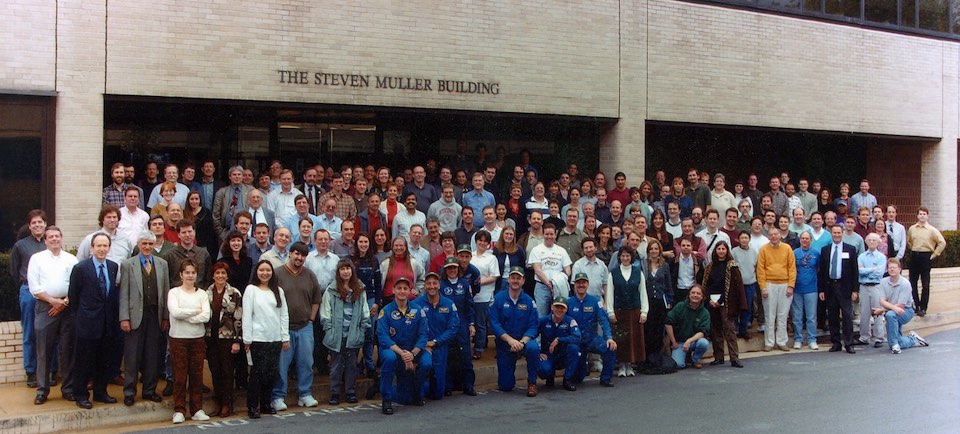
Servicing Mission 4 - On, Cancelled, On, Delayed, and Finally On Again
SM4, originally scheduled for 2004, was cancelled after
Space Shuttle Columbia came apart on re-entry on February 1, 2003.
NASA began to explore the possibility of devising a robot to carry out SM4.
At the end of October 2006, NASA came up with a plan to safely
send a Shuttle to service Hubble.
SM4 was then scheduled to October 2008, but postponed
again to allow for replacement of
Science Instrument Command and Data Handling Unit (SI C&DH)
that malfunctioned just over two weeks before the planned launch date.
Shuttle Atlantis (STS 125) finally got off the ground
at 2:01 PM EDT on May 11, 2009, right on the new, revised schedule.
The crew was Michael Massimino, Michael Good, Gregory Johnson, Scott Altman,
Megan McArthur, John Grunsfeld and Andrew Feustel.
Massimino, Altman, and Grunsfeld had participated in earlier servicing missions.
They installed the Wide Field Camera (WFC) and the Cosmic Origins Spectrograph (COS),
replacing 1993’s WFPC2 and COSTAR. In unprecedented activities, they
repaired the ACS and the STIS.
They installed six new gyroscopes and the replacement SI C&DH.
They attached a new device, the “soft capture mechanism” that will allow
a robotic spacecraft to join itself to Hubble and de-orbit it once the telescope
reaches the end of its life.
Finally, they covered key Hubble equipment bays in fresh insulation,
also called a New Outer Blanket Layer (NOBL).
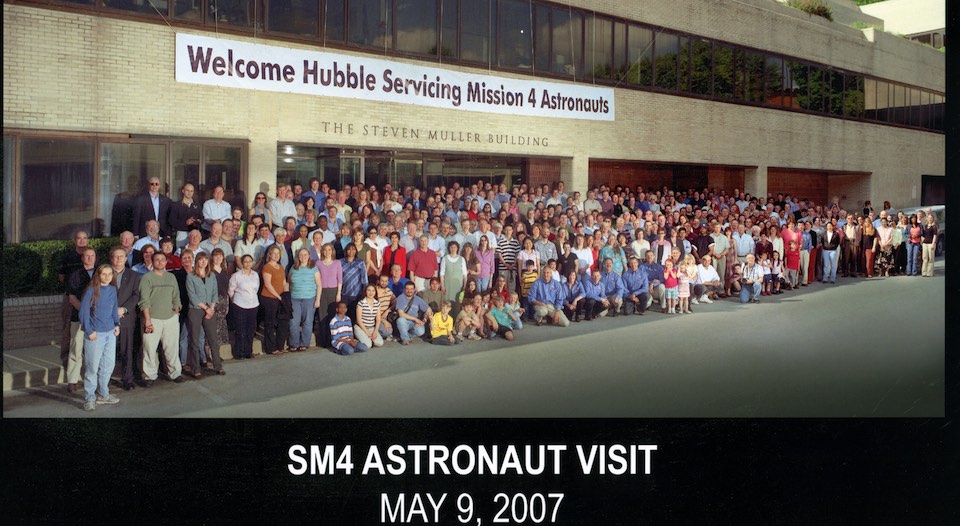
|
STScI folk waiting at the hotel for the bus to KSC
|
Wayne Baggett with camera on KSC’s causeway
|
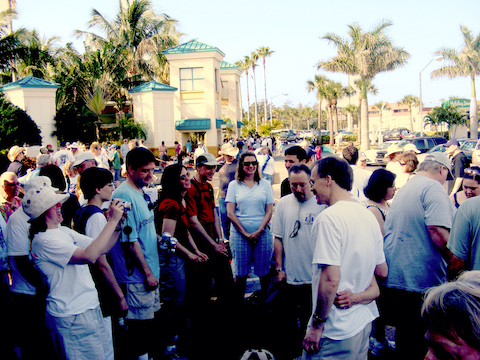
|
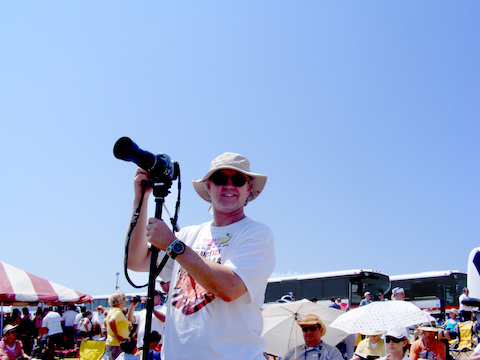
|
spaceflight.nasa.gov/gallery/images/shuttle/sts-125/hires/sts125-s-031.jpg
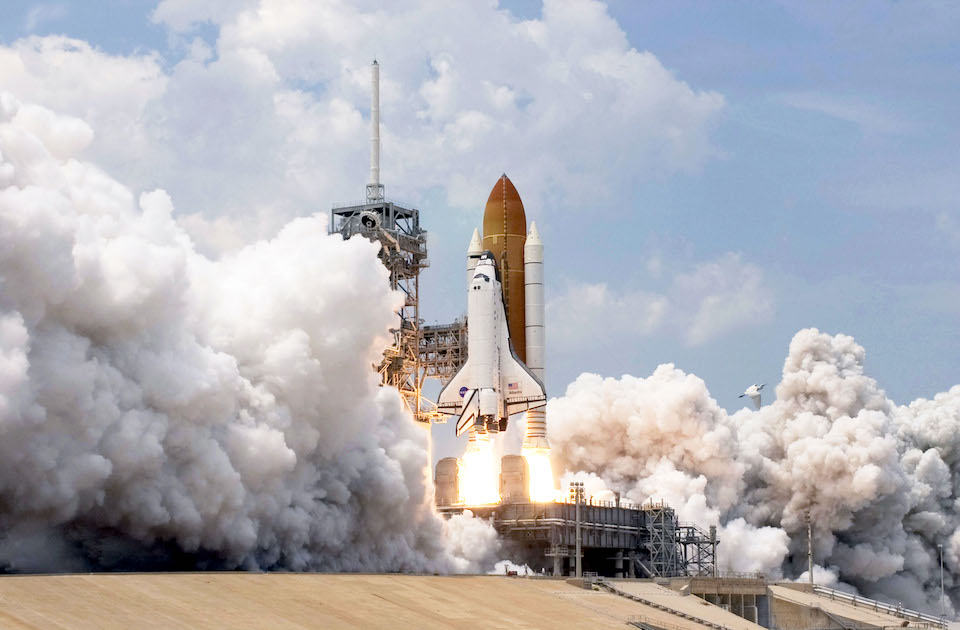
Celebrating the success of SM4
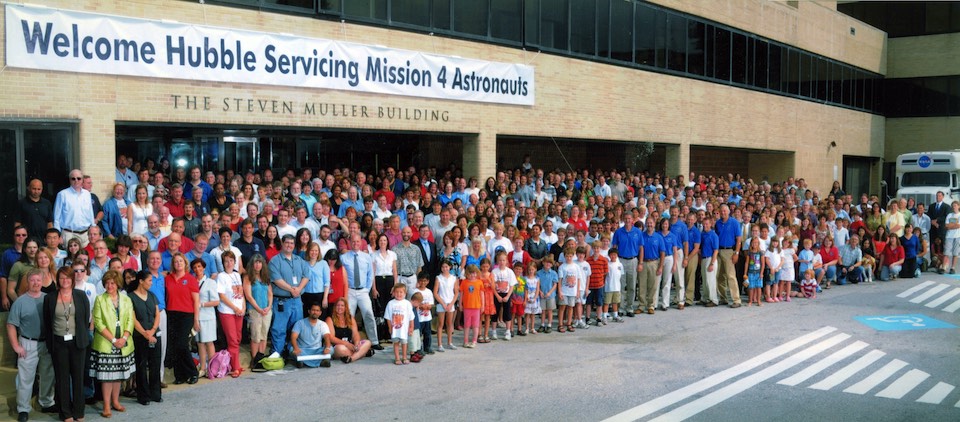
It has been 11 years since Servicing Mission 4.
Hubble Space Telescope is continuing to be well used and to produce
astronomically exciting data.
Olivia Lupie and Merle Reinhart gave an update on its condition.
Three of the six gyros have died, but the project has a one-gyro control system.
Under the one-gyro control, the telescope will be less efficient but it still
capable of generating high-quality observations.
In Memoriam
These names were complied by Jack MacConnell. They are listed here by the organization
that signed their paychecks, but all are STScI team members.
- CSC folks: John Baum, John Bedke, Terri Gipson, Al Havrilla,
Ron Holland, Charlie Kowal,
Howard Lanning, Gabriel Menchaca, Clark Merrill, Paul Paluzzi, Ron Pitts,
Ralph Reitan, Carol Schweihs, and Conrad Sturch
- AURA folks: Ronald Allen, Pearl Bailey, Wes Brown, Robert Denman, Rodger Doxsey,
Rebecca A. W. Elson, Anatoly Evzerov,
Jim Fraher, Riccardo Giacconi, Gary Gladney, Michele Roth Gleason, Barry Lasker, Andy Lubenow,
Teri Mackay, Russell Makidon, Stephen Murray, Tawanta Nance, Marco Oliveri,
Paul Paulsen, Mark Sienkiewicz, Marilyn Thompson, Frances Twele, Nolan Walborn,
- ESA folks: Tomas Dahlen, Francesco Paresce, and Christopher Skinner
- TRW folks: Steve Southgate
This photo was taken after the memorial service for John Baum: Jack MacConnell, Conrad Sturch,
Colin Cox, Gail Holm, Albert Holm, Dorothy Fraquelli, Olivia Lupie,
Donna Swade, and Daryl Swade.
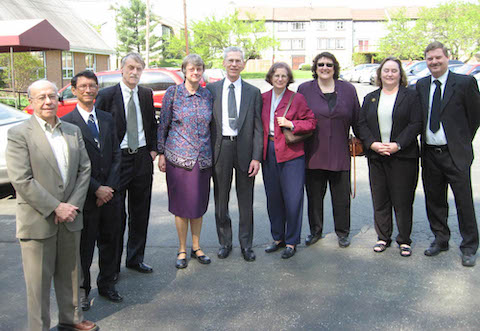
Zoom Gathering
Here is a video of the gathering we had on April 24 to celebrate the 30th anniversary
of the launch of the Hubble Space Telescope. Many thanks to Mark Kochte for converting it from
the Zoom format to .mp4.
The recording begins after the toast and
after Olivia told about asking Mike Bielefeld to give her eulogy.
But it does have everyone's story.
Video of Gathering of Old Timers for the 30th
Anniversary of the Hubble launch
The following old timers participated:
Tom Ake
Chris Anderson
Sylvia Baggett
Wayne Baggett
Vicki Balzano
Mike Bielefeld
Eric Chipman
Ian Cooper
Colin Cox
Tracy Ellis
Jim Etchison
Pat Parker Fraher
Dorothy Fraquelli
Danny Golombek
|
Forrest Hamilton
Helen Hart
Al Holm
Ed Kemper
Debbie Kenny
Mark Kochte
Vicki Laidler
Zolt Levay
Ray Lucas
Olivia Lupie
Jack MacConnell
Brian McLean
Glenn Miller
Sid Parsons
|
Alan Patterson
Jim Phillips
Merle Reinhart
Jim Rose
Glenn Schneider
John Scott
Mike Shara
Barry Turnrose
Phil Van West
Glenn Wahlgren
Ed Wells
Karl Whittenburg
Bill Workman
Jim Younger
|
The screen shots below were shared by Danny Golombek.
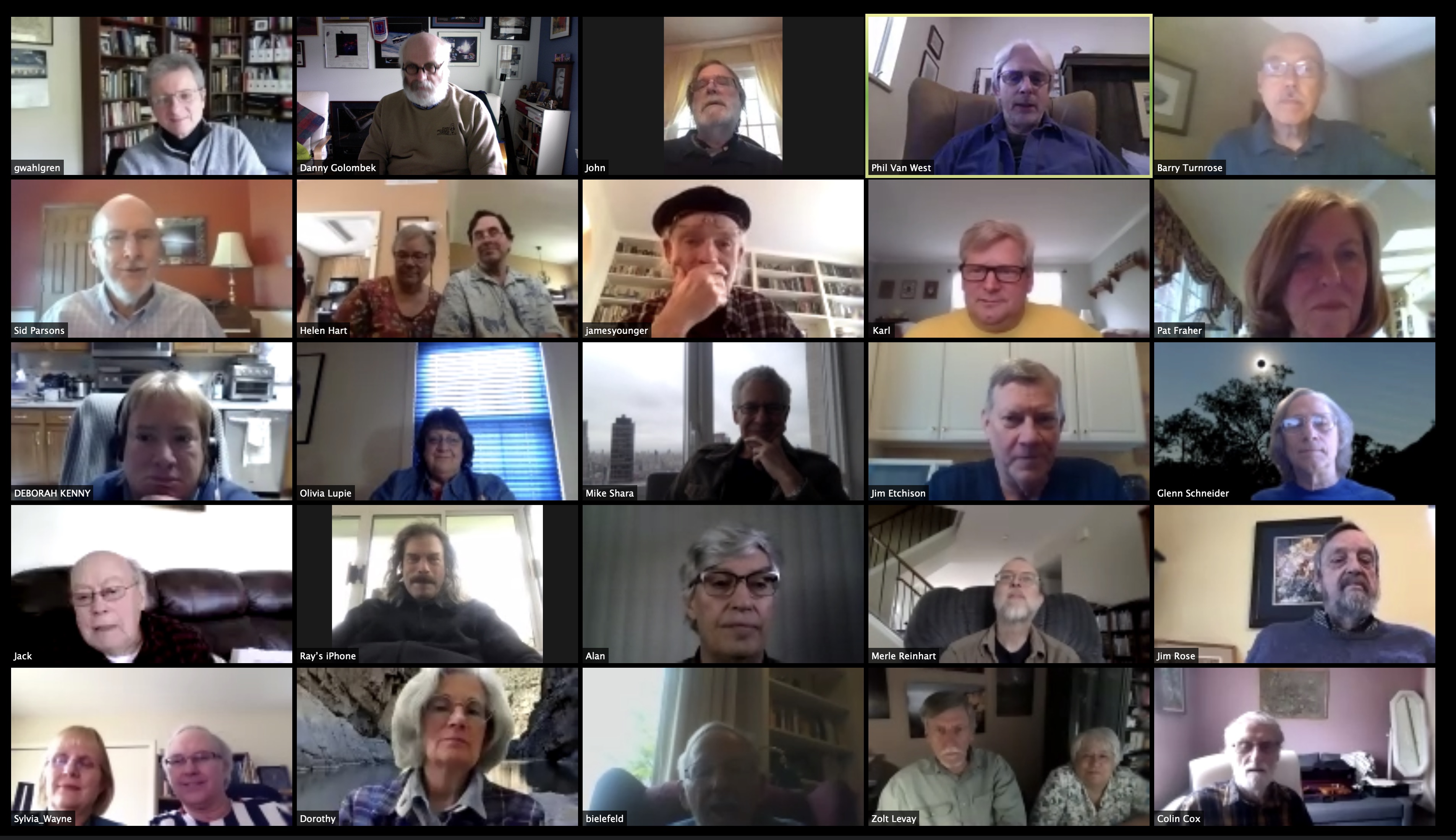
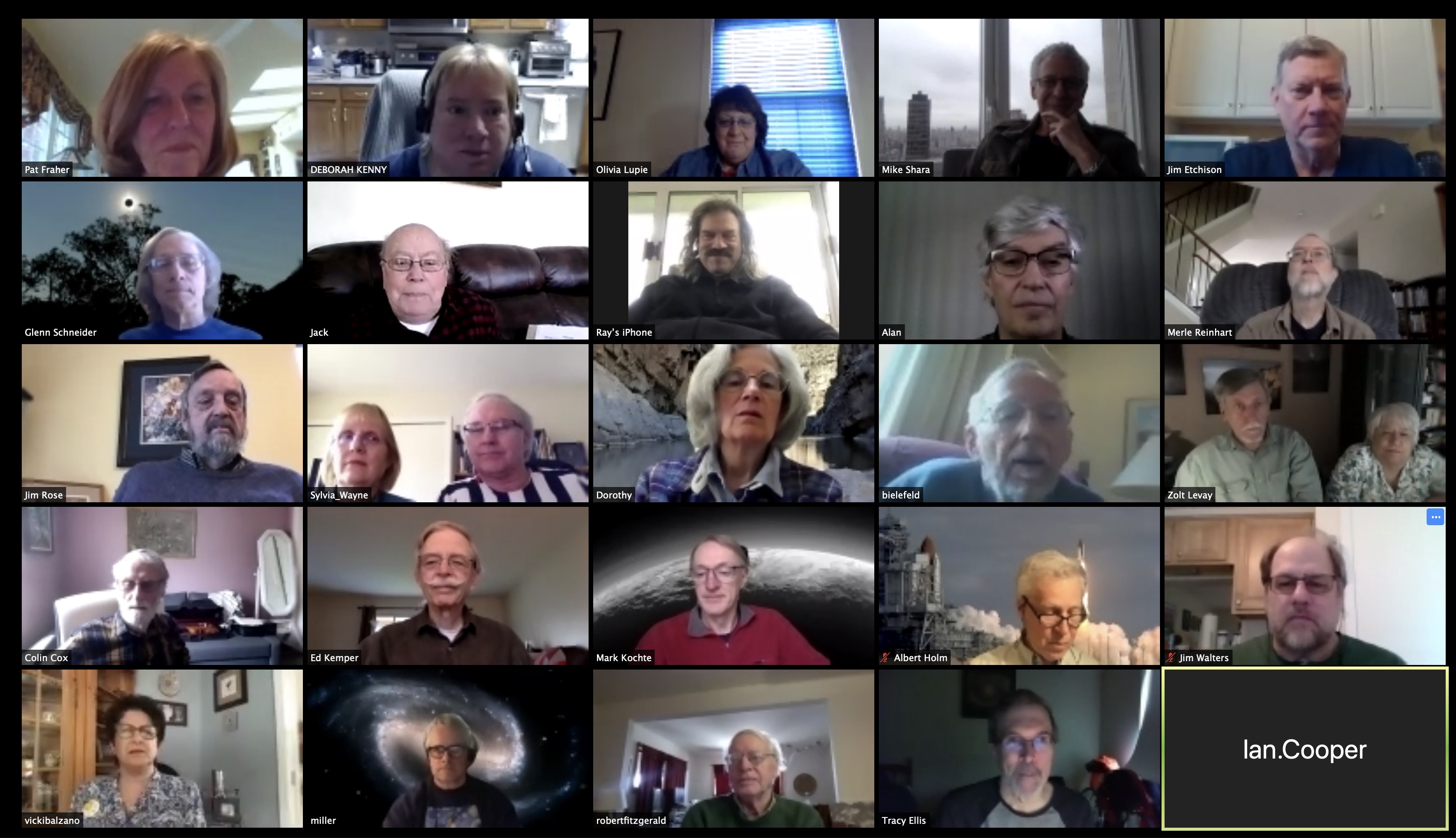
Other Videos and Papers
Olivia Lupie called our attention to the two NASA videos that commemorate the Hubble’s
anniversary. Sylvia Baggett let us know about the article by Bob Williams in
Research in Astronomy & Astrophysics.
- This is a 51-minute history of the Hubble and some of its discoveries.
NASA's Incredible Discovery Machine:
The Story of the Hubble Space Telescope51 minute story of Hubble
- This is the press release for the anniversary. It includes a 3 1/2 minute video.
Hubble Marks 30 Years in Space With Tapestry of Blazing Starbirth
- Bob William’s article
“Hubble Telescope 30 Years in Orbit: Personal Reflections”
Anecdotes That We Shared
This section collects the memories we shared, mostly after our Zoom session. At first
they were in response to Anatoly Evzerov’s family’s request for stories and
photos of him to replace ones they’d lost during tropical storm Sandy. Then
they went more broadly to stories of other people and things.
Jack MacConnell on April 23: [Ethan Shreier] and I both play banjo - so did Dimitri Mihalas.
Debbie Kenny on April 29: I remember Anatoly [Evzerov] telling us the Russian cure
for the common cold: A glass of vodka and a drop of water. Still makes me laugh!
Al Schultz on April 29:
I worked with Anatoly [Suchkov] on a paper. It has been a long time.
Anatoly was first author. I do not remember the title of the paper or the journal.
I seem to remember Anatoly was invited to present the results of the paper at a colloquial.
He had to fly. Possibly U. Texas? I am not sure. Possibly, an internet search will locate the paper.
I googled on my cell phone and didn't find the paper. I do not have access to my publication list.
Also, at that time, I was searching my family's history in Russia.
I paid a researcher to search in the Russian military archive.
Anatoly was kind enough to read copies of old Russian documents
and compare to the translation the archivist included with the documents.
Only once did Anatoly find a minor error in translation.
I really appreciated Anatoly taking time to read and translate the documents.
It was very good to have a second person go over the documents.
I thanked Anatoly many times for reviewing the documents.
Sorry to say, I do not have any photos of Anatoly.
Ian Cooper on May 1/2020: One evening, Anatoly [Evzerov], Dan Rehner,
Phil Shank and I headed over to
PJ’s Pub for supper. Needless to say we started off from his machine
shop after a few “sips” of vodka from his private stash.
Anatoly was so very proud of contributions to 236" BK-6 altazimuth
mounting as he proceeded to demonstrate by wiping off PJ’s beer
specials chalkboard. A rough sketch, his arms pumped up from his side,
and the words “strong like bull” was his description.
I do own a piece of his talents. The finder scope for my 10" Cave
never had a dew cap. Thanks to Anatoly I now have one!
Chris Anderson on May 1/2020:
Two stories Anatoly told me that I still retell to this day:
Before the collapse of the USSR, Anatoly and his colleagues had a hard
time obtaining alcohol pure enough for cleaning optics. So, whenever
they’d get permission from the State to travel to scientific conferences
in the West, they'd go to the liquor stores and buy bottles of pure
grain alcohol (Everclear) to bring home. The problem was, when they
tried to get it back into the USSR, the Soviet customs officials, upon
finding it in their luggage (not having been concealed), assumed it was
their bribe to look the other way from some other hidden contraband, and
would abscond with it. So Anatoly and his cohorts would have to explain
that they were not smugglers and really needed the alcohol for their optics!
The other story was on the night of “first light” for the 236"
telescope, where all the Soviet bigwigs were in attendance to toast
their technological supremacy over the Americans' 200" (Palomar). It was
a party atmosphere, with everyone drinking vodka while the telescope
tracked a target through the sky. Since the telescope is an
altitude-azimuth mount, both axes must be driven to track targets. What
no one knew was that the programmers had made a quadrant error in the
trig functions of the tracking software. So, well into the evening,
after the focus had shifted from the telescope itself to
self-congratulation and revelry, as the telescope crossed the meridian
(into a new quadrant), the tracking software decided that the telescope
was upside down, and immediately switched from its stately tracking rate
to its highest slew rate to “right itself”. All the engineers knew was
that the telescope was suddenly moving rapidly for no apparent reason,
and immediately dropped their drinks to scramble to shut it down,
fearing it was out of control. From the bigwigs’ viewpoint, the party
suddenly went from toasting and good cheer to panic and frenetic
activity. Hilarious, in retrospect.
|
Ian Cooper shared this note from Paul Olson on May 1:
Hey Ian,
Well, I might not have been able to be on the Zoom call last Friday,
but look at the U-Haul truck I ended up getting Friday totally by
chance. It was parked tightly against other trucks when I picked it
up, and I didn't even realize it until I got the truck home and was
able to stand back and take a look at it. When I saw it, it was like,
“YES! HUBBLE 30 YEARS!! And I was part of it!” Feel free to post it
to the Hubble Facebook group or wherever you all were coordinating the
call. This photo was taken when we were unloading it into the storage
facility yesterday.
Stay safe. More later.
Paul
|
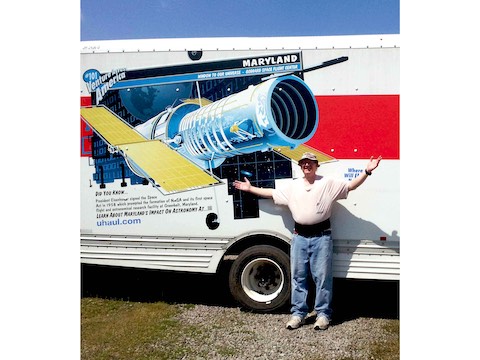
|
Jack MacConnell on May 1/2020: I have a story that I didn't mention
in the session. It happened in the early 90’s, after launch
but before the 1st Servicing Mission.
My shift was over and I was driving out the lower exit of the parking garage
about 4:30 when I looked across the road at the building and saw,
seated on the stairs with his head in his hands as though he had not a friend in the world,
Lyman Spitzer, the Father of HST.
It was one of those “I wish I had a camera” moments.
He was waiting for a taxi after what appeared to be a long day of meetings.
His
obituary is here.
Albert Holm on May 2:
Here’s an observation about Lyman Spitzer, not much of a story.
When Copernicus (OAO-3) was being prepared for launch,
Spitzer would visit Goddard from Princeton. One day, I encountered him at the xerox machine,
doing his own copying.
Many senior managers would have delegated that job to a secretary,
but Spitzer did his own work.
Olivia Lupie on May 4: So love the Lyman Spitzer stories.
I don’t have much of a story - just that I charged out my office on the 3rd floor
and almost knocked him over. When I saw who it was --- my jaw must have hit the floor
because he laughed. He was amazing!
Rusty Whitman on May 4: Remembering Barry Lasker:
When we moved from Latrobe Hall into Muller my office was down on the first floor
and Barry Lasker had his office at the north end of the hall.
I spent a good deal of time down there as we were trying to get the GSSS VAXes
to reliably talk to the PDSes.
Barry had a coffee mug on his desk, black with white lettering, that said,
“Conscious Expectation of the Unexpected”.
I loved that saying. An elegant re-phrasing of the Boy Scout motto
and one that would become the unofficial motto of STScI.
One day I asked Barry where he had gotten the mug.
He sighed and smiled and told me that it was from a previous project
that he had worked on building an instrument.
Everything seemed to go wrong on the project.
They had problems with parts, key people had accidents that kept them out of work
for extended periods, they kept getting further behind schedule,
basically an embodiment of Murphy’s Law.
One Monday, after a particularly bad week they all arrived at work
to find those coffee mugs on their desks, courtesy of the Project Manager.
Barry did say that they eventually got things working
and delivered the instrument but it was an experience that no one wanted to repeat.
Second story - Years ago, Russ Makidon and I were talking
and knowing I had been at STScI in the early days he asked me about the origin of the SDAS Meeting.
I knew all about it since I was there at its inception,
so I wrote up the following and sent it to him in an email.
In the fall of 1981 the SDAS group at STScI consisted of Kit Harvel (task lead),
Jim Rose, and myself. Rudi Albrecht was the AURA manager.
As I recall, it must have been the Spring of 1982 that we got our task order for the year from Rudi.
In the task order was a requirement that the SDAS group hold a weekly management meeting.
We decided that we would hold our management meeting at a time and place of our choosing.
The time chosen was 5pm on Wednesdays and the place was Levering Hall,
which at that time served beer.
This was all spelled out in the response to the task order and sent to Rudi,
who was invited to join us.
Unfortunately that founding document has been lost to the ravages of time.
But so was born the SDAS Management Meeting.
We continued to meet at Levering until they raised the drinking age
and Levering stopped serving beer. For a time we met at P.J.’s.
Once the Institute building was completed and we moved in,
our meeting was held in the original cafeteria on the ground floor
and was opened to one and all.
At that point we also set up a list for people to sign up to bring beer.
I’m quite certain its the longest running regular meeting that STScI has
and probably one of the most valuable.
Zoltan Levay on May 4:
I guess it’s not the same one that Barry had from the previous project,
but I did get a mug with the same motto on it very early in my time at STScI.
Since it says “Space Telescope” - sans Hubble, it must have been well before launch.
(Also note the old NASA worm logo, not the meatball.)
Bill Hathaway on May 4:
I had long wanted to know where the “Lyman” [of Lyman Spitzer’s] name came from.
His Wikipedia page mentioned that “Through his paternal grandmother, he was related to
inventor Eli Whitney.” There have been many other Whitney’s in American history.
The line goes: Lyman Strong Spitzer Sr, son of Sarah Elizabeth Strong, daughter of
Lyman Whitney Strong, son of John Stoughton Strong (leading founder of Strongsville, Ohio)
and Tarmar Whitney. But why Lyman? Tamar had a sister Irene Whitney, married to
Elijah Lyman, which family also settled in Strongsville. I see no direct descent from the
Lyman family name, but the Lyman’s, Strong’s and Whitney’s had several
prior generations of marriages, so the the name was well known to his line.
Now, it is rarely included, but the “Strong” in
Lyman Strong Spitzer rings a potent bell in American history.
The progenitor of most Strong descendants was Elder John Strong (~1609-1699),
who with his second wife, Abigail Ford, had many children,
with several lines to Lyman Whitney Strong, including a separate line to Elijah Lyman.
First wife of Elder John, Marjorie Deane died 1635 on their Atlantic crossing to New England
along with an infant child.
Their one surviving son, John Strong Jr. became the ancestor to Brig Gen Strong Vincent, age 26,
who was mortally wounded defending Little Round Top, Gettysburg July 1863,
leaving a young pregnant widow, Elizabeth Carter.
A first cousin to Elder John was a William Strong, whose 10th Great-Grand-daughter
is [actress] Cecily Legler Strong of current renown.
[Click here for an ancestry chart for Lyman Spitzer, Jr.,]
that may seem far more information than reasonable, but in this
vast universe, it gives a context to here and now.
If you follow it, you’ll see Lyman’s connection to Edwin Hubble - many early New England
families are related in very many ways.
Lyman was also 8th Great-Grand-son of Gov William Bradford,
leader of the first arrivers on the Mayflower, November 1620,
the many descendants of those who survived that first winter,
would have massively gathered in Plymouth, Mass this year,
but for social distancing.
Enjoy or ignore.
Jack MacConnell on May 14:
I have two stories about our second director, Bob Williams.
For about my last decade at the Institute,
my office was an interior one on the 3rd floor just feet from the rear entrance to the
director’s office.
One afternoon, Bob showed up at my door in a bit of a panic asking
if I knew the Unix command to stop a print job! Too bad, but I didn’t at
the time - maybe I told him to turn the printer off or remove the blank paper.
The other story has to do with the planning sessions in Bob’s office
for the Hubble Deep Field. After SM1 and the installation of WFPC2,
Bob allocated about 150 orbits of Director's Discretionary Time
to image a tiny, “empty” patch of sky in Ursa Major
and go as “deep” as possible.
There were perhaps 6 or 8 Institute astronomers who met with Bob to plan the program,
and he left the back door open for stragglers.
I couldn't hear the discussions but remember occasional gales of laughter coming from the room;
Bob liked beer
and no doubt was sharing his latest favorite brew with the team.
HDF and its successors will go down as among the most important of HST’s achievements.
It’s nice to think about it being conceived in a spirit of joviality.
Ray Lucas on May 15:
Sometime within the past year I had reconnected with Gary Gladney via Facebook,
and he had even commented in a nice way a few times on things I had posted,
so it was something of a very sad shock to read of his passing when Al sent
the news [of his death from complications of covid-19] around the other day.
I had even thought of him in the last couple of weeks in relation to something
interesting or tasty about some Korean food I had seen on a broadcast recently
and it brought to mind some of our conversations many years ago about things like that.
I’ve always had very good memories of Gary - you couldn’t ask for
a nicer person to have a conversation with - always friendly and nice to be around.
He will definitely be missed by many, I’m sure.
And it makes this current pandemic even more personal - we all know it logically,
but it is not just statistics that are affected – it is real people.
RIP Gary. You were always a good friend and co-worker.
As for your Bob WIlliams stories, Jack, I can relate to those, too.
You may recall that my office was down the hall from you a couple of times.
In fact, one of the two offices I occupied over the years there was Bob’s former office
after he had been Director - my office-mate at the time, Matt McMaster,
and I traded offices with him when he became IAU President and needed more space.
I can recall Bob coming down the hall and asking me if I could quickly
measure a magnitude of a star in an image - a quick aperture photometry measurement
like in IRAF/PyRAF apphot - and other technical assistance like that with either a measurement
or a quick “how to” question about some software.
And I was one of the people in his office for those HDF Team design
and planning meetings from pretty much the beginning.
Though I never went to the science coffee meetings that Bob talks about in his book,
I had been asked by Alan Dressler to design the SM1 WFPC2 ERO program
on the medium redshift (z ~0.4,
and with a possible quasar with another cluster around it at z~2.5 in the field)
galaxy cluster CL0939+4713 aka Abell 851 - something he had put a bug in Bob WIlliams’ ear
about as well as later advocating to him - on a long flight from Chile,
as I recall the story going - that we should attempt to do a “deep field” of some sort.
Since the WFPC2 CL0939+4713 SM1 ERO observations had been so successful,
and since Mark Dickinson’s z~1 radio galaxy observations had, as well, Bob,
Mark Dickinson, and Harry Ferguson came to me to ask about possibilities for observing.
I talked almost daily with Mark and Harry about various aspects of it from the beginning
because we were trying to figure out if it might even be possible to do and schedule, etc.
I was trying informal experiments to see what might work in terms of the program design
and target areas and CVZ, etc., and I must say that, yes,
despite the view that it was risky in some ways (so much very expensive telescope time,
and possibly for what?!), we did laugh a lot from time to time!
I think it was such an adventure in many ways that we were all sort of out on a limb,
hopeful that it would be fruitful, and even somewhat confident
that it would be an interesting result no matter what we found, or didn’t,
though the latter case might have made us pariahs of a sort for some time...
It was pretty exhilirating to be out on that limb,
and, I think, whether it was “nervous” laughter or “fun” laughter,
it was probably some of both, because the historic nature of getting to do some
audacious thing gives you a feeling of being some kind of co-conspirator and engenders
that feeling that Ben Franklin described once (I paraphrase) - we’d best all hang together,
or surely we may all hang separately.
We had our disagreements over some things from time to time,
but we always worked them out via the group discussions and experiements
or more research (as best we could) to help decide the issues.
I was part of the teams on all the other big extragalactic DD programs we did after that
(HDF-S, HUDF, Frontier Fields), but there was definitely always a more special feeling
about that first one because we weren’t REALLY always sure of what to expect
in so many various aspects of the program, from the number of galaxies we might find
at different possible redshifts, to the usefulness and practicality of sub-pixel dithering,
to the degree of effects of zodiacal light and/or scattered Earthlight
on the deep background in the images, or the operational and engineering
and temperature effects in the aft shroud etc. of running multiple instruments
for long times at one orientation with respect to the sun.
People often don’t remember, and even I don’t remember now
exactly how we did it - maybe via another program ID with
interleaved observations? - but we used both WFPC2 and FOS - we also did
spectral measurements of a “blank or dark spot” in the sky with FOS
for Rebecca Bernstein and Larry Petro, who was also part of the HDF team.
With some verification from Merle Reinhart that the guide stars we were
using were in a “well-behaved” part of the FGSs,
and using a deeper KPNO 4m image to which I had transferred the GSC reference
frame using ways I had learned from Brian McLean in my Guide Star group days,
I was the person (working along with input from Mauro Giavalisco)
who actually determined the exact final pointing of the HDF,
and though hardly anyone else knows or remembers it,
and though we ultimately never observed it due to concerns about power
and heat and data rates, etc., since it was still being discussed at the time,
in accordance with Duccio Macchetto’s wishes as FOC GTO PI,
I had also placed a galaxy in one of the FOC camera apertures
in case events had somehow dictated that we use it.
So a dark spot for the FOS aperture and a galaxy in one of the FOC camera apertures
helped determine the exact final pointing of the HDF.)
I’m forever grateful for just getting to be a part of it from early on
and in ways I never would have guessed or imagined as that initial experiment
and then that whole area of study blossomed, especially since no less than John Bahcall
had famously said that HST wouldn’t be good for things like that.
Albert Holm on June 3:
I made a spicy curry for dinner and it got me to thinking
about the many CSC job interviews I participated in while at the ST ScI.
In the early days, we would interview the candidate in the morning
and then walk over to Uncle Lee's Restaurant on Greenmount Avenue for lunch,
where we could get to know the candidate informally.
Over time, we moved on from Uncle Lee's,
and sometimes we'd have our interview lunch at the Thai Restaurant, also on Greenmount.
It is still there. At one of these lunches, I ordered their lamb vindaloo.
Wow! That really brought the sweat out on my brow,
and my dinner this evening reminded me of that.
One candidate interview stands out in my memory more than others.
In those early days, we would interview the job seeker in a group.
The managers would gather in Charlie Wu's office,
and we would all ask questions of the candidate.
That seemed like the most efficient way of doing things.
The candidate would not be asked about the same things over and over,
and the managers would all benefit from hearing the answers to questions posed by others.
In later years, this style of interviewing was labeled "gang banging",
and we moved to one-on-one interviews.
Anyway, one winter morning the managers gathered in Charlie's office to interview a candidate
for Science Operations Specialist that CSC was bringing in from Chicago.
The time came for the interview to start and there was no candidate.
We chatted among ourselves. A half hour passed. An hour.
Finally we decided that something went wrong.
Maybe the candidate decided he did not want the job.
And we went back to our offices. Then Charlie got the news.
Gabe Menchaca, our candidate, had been coming to the interview in a rental car
on San Martin Drive.
When he got to the place where the San Martin Center parking garage is now,
the car skidded on an icy spot, and he went over the edge into the valley below.
Luckily, he was not injured, and we were able to interview him later that day.
Despite the accident, Gabe was hired, and that was a good decision for the Institute.
Jack MacConnell on June 4:
Thanks for the story about Gabe - he and I were both from Chicago
where winters can be quite brutal, so he should have been used to driving in icy conditions.
But I had a similar accident coming in for the evening shift once, so who am I to talk?!
After Teri died, he was clearly despondent and we went out to lunch or for walks together,
but he never opened up very much to me even when I encouraged him to speak Spanish.
A while later I came home from a trip to Cerro Tololo to find a phone message
from Mike saying that Gabe had died and telling me where he was laid out.
I went and sat with his mother and siblings trying to assuage their grief.
It was a very difficult time for all
Albert Holm on August 8:
Ed Smith shared a meme on Facebook about discussions to keep cats
from accidentally commanding spacecraft while the controllers are working
from home [during this time of Covid-19].
Ricardo Giaconni banned animals from the Science Institute building several years
after we moved in. I don't remember exactly when it happened.
Maybe Olivia Lupie would remember.
I do recall that one of our colleagues in Planning & Scheduling had
to remove the terrarium with his rattle snake from his office.
He gave me some goldfish that his snake had not eaten.
|
Danny Golombek on August 8:
It turns out that Francesco Paresce used to bring his dog to the ’tute
and someone complain about the barking. So Riccardo sent the memo below.
Calvin Tullos on August 9:
My recollection was that someone left their dog in their office over night.
Of course the dog barked at the cleaning crew and that shut everything down.
My favorite was standing at the elevator one day. It opened to Ricardo
with his Newfoundland which was as big as a horse.
I had to work some Saturdays and would bring my dog.
He was old and chill so no problem.
The guys on the ground floor had to get rid of their aquarium of snakes
but don’t remember much more fall out.
Glenn Miller on August 9:
Here’s how I remember it - no guarantee this is what really happened.
The 2nd floor of the parking garage had been converted to offices,
and one of the postdocs would bring his cute, little fluffy dog to work.
One day, another staff member got frustrated with the copier
and proceeded to loudly beat on it and curse.
The dog, sensing misuse of government equipment, uttered a few “arfs”.
The staff member, who outweighed the dog by an order of magnitude,
considered this a personal threat and reported it to the director.
|
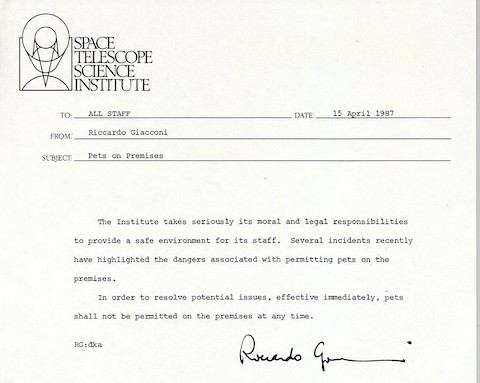
|
Ray Lucas on August 9:
My introduction to wildlife at the Institute came early on in mid-1985
when working late one night in my office in the front part of the
Guide Star group’s area on the 1st floor.
Sitting at my desk which was by the Halon Control panel in the front room
by the door when then opened into the main hall back in those days
(it was moved to the side in muhc more recent times),
it was nearing midnight and I was getting tired and sleepy.
While staring with tired eyes at something on my computer screen
and trying to make sense of what I was seeing, I suddenly thought
I saw a piece of the gray carpet zip across the floor.
Thinking I was really getting too tired and it was time to go home,
I turned and stared at the area in front of the door to the GS Plate Vault
and thought I must have been starting to hallucinate when suddenly
while staring straight at it, that gray piece of carpet zipped
back across the gray carpet in the other direction again.
I could still hardly believe my eyes because I was tired, but I _knew_
I had seen something zip quickly across the floor, and I suspected it might have been a mouse.
Awake now, I kept staring, and sure enough, eventually the mouse ran out again,
but this time it stopped for a brief fraction of a second before
finishing its dash across the floor, and I saw it clearly and knew it was a mouse.
Or perhaps it was a different mouse, because where you see one, there are likely more.
And where there are mice, snakes will try to follow.
At that point, being more awake, I finished what I was doing first, and then finally went home,
glad at least that I wasn’t imagining things,
but realizing that the Institute might also be a zoo of sorts... ;-)
I didn’t have a cat back then, and I suppose that letting the rattlesnakes
down the hall loose to hunt the mice wouldn�t have been seen as a good solution ;-),
but after that I always wished we could at least bring cats to work,
even if larger pets like dogs weren�t allowed.
By the time I later had offices on the ground Floor, 4th floor, and 3rd floor,
4th floor again, and then the 3rd floor again,
I had either one or two cats at various times,
and I occasionally saw mice at night out in the hallways
and in offices on all of those floors.
I know we couldn’t have done it - there were of course people with cat allergies
and there would have been concerns about litter boxes and water dishes and etc.,
and with cats being so territorial, it probably would have freaked the cats out some,
too, to be in a new strange place with lots of other cats down the hall
or the other side of the office, but there sure were some times
when I would have loved to have had a few “bring your cat to work” days... ;-)
Of course, the wildlife that was much more fun or funny to watch consisted of the
red-tailed hawks in the trees and the herons in the Stony Run Creek behind the Institute,
and the occasional Hopkins ROTC camouflaged guys running around in the woods
trying to surprise each other while people were ambling
through their midst on the paths and bridges, jogging and walking their dogs, etc.,
and of course, the occasions from time to time
when dogs and people would be playing fetch and frisbee and soccer or American football
or playing in the autumn leaves or cross-country skiing and playing in the snow in the park. ;-)
The snakes down the hall probably weren’t rattlesnakes or poisonous snakes of any kind...
It just came to mind and sounded funnier as I was typing my recollection,
so a bit of “poetic license” there, I expect...!
Maybe someone else on here remembers what they actually were -
they were probably non-poisonous rat snakes or something like that.
They probably would have been perfect to let loose after the mice! ;-)
Eddie Wells on August 9:
These stories have reminded me of a couple. During the night shift in OSS and SPSS,
it was very common to see mice running around the OSS room.
We always thought they lived in the space below the false floor.
Someone set one of the “mouse motel” traps,
which were baited open-ended boxes with a very sticky Substance on the walls.
Well, on night we caught one and the poor thing was thrashing about madly trying to escape.
What to do? There were 3 or 4 of us macho men present
but not one was willing to dispatch the mouse.
Finally, one of us took the motel out in the back yard and cut the mouse the mouse out of the box.
I believe thousands of its descendant now live out in the park (the ones not eaten by the hawks).
One day I left the Institute and walked south on the sidewalk along San Martin.
Just at the end of the building there was a black rat snake traveling in the same direction.
It was the largest snake I have ever seen in the wild; over six feet long.
It finally crawled under the space below the sidewalk where I suppose he lived.
I never walked along there at night after that.
Eliot Malumuth on August 10:
I had to take the Beta Fish I had in my office home because of this.
I don’t think they were Rattle snakes.
But they belonged to Steve Kraemer and were in the office he shared
with Don Chance (next door to mine on the ground floor).
Responsible: Albert Holm
Date: 12 May 2020; Revised: 12 August 2020, 3 March 2023









 Agenda from the June 15, 1983, dedication of the STScI
Agenda from the June 15, 1983, dedication of the STScI








